Testing Trace-Element Distribution and the Zr-Based Thermometry of Accessory Rutile from Chromitite
Abstract
:1. Introduction
2. Methodology
3. Geological Setting and Petrographic Notes
3.1. Bushveld Layered Intrusion (UG2 Chromitite Layer, Merensky Reef)
3.2. Jacurici Mafic-Ultramafic Sill (São Francisco Craton)
3.3. Loma Peguera (Loma Caribe Ophiolite)
3.4. Nuasahi Layered Complex (Singhbhum Craton)
3.5. Cedrolina Ultramafic Body (Pilar de Goiás Greenstone Belt)
4. Chromite Mineral Chemistry
4.1. Unmetamorphosed (Magmatic) Chromitite
4.2. Metamorphic Chromitite
5. Rutile Modal Abundance and Textural Relations
6. Trace Element Composition of Rutile from Chromitite
7. Zr-Based Rutile Geothermometry
8. Discussion and Conclusions
8.1. Significance of Rutile-Chromite Textural Relations
8.2. Chromium and Vanadium in Rutile from Magmatic and Metamorphic Chromitites
8.3. Significance of HFSE (Niobium-Zirconium-Wolfram) in Chromitite-Hosted Rutile
8.4. Zr-in-Rutile Thermometry of Chromitite
8.5. Origin of Rutile-PGM Inclusions in Chromite
8.6. Comparison of Accessory Rutile in Chromitite with Rutile from Other Petrologic Associations
Author Contributions
Funding
Data Availability Statement
Acknowledgments
Conflicts of Interest
References
- Meinhold, G. Rutile and its applications in earth sciences. Earth Sci. Rev. 2010, 102, 1–28. [Google Scholar] [CrossRef]
- Zack, T.; Kooijman, E. Petrology and Geochronology of Rutile. Rev. Mineral. Geochem. 2017, 83, 443–467. [Google Scholar] [CrossRef]
- Meinhold, G.; Anders, B.; Kostopoulos, D.; Reischmann, T. Rutile chemistry and thermometry as provenance indicator: An example from Chios Island, Greece. Sedimen. Geol. 2008, 203, 98–111. [Google Scholar] [CrossRef]
- Ferreira Filho, C.F.; Kamo, S.L.; Fuck, R.A.; Krogh, T.E.; Naldrett, A.J. Zircon and rutile U-Pb geochronology of the Niquelandia layered mafic and ultramafic intrusion, Brazil: Constraints for detailing of magmatism and high grade metamorphism. Precambrian Res. 1994, 68, 241–255. [Google Scholar] [CrossRef]
- Rudnick, R.L.; Barth, M.; Horn, I.; McDonough, W.F. Rutile-bearing refractory eclogites: Missing link between continents and depleted mantle. Science 2000, 287, 278–281. [Google Scholar] [CrossRef] [Green Version]
- Zack, T.; Kronz, A.; Foley, S.F.; Rivers, T. Trace element abundances in rutiles from eclogites and associated garnet mica schists. Chem. Geol. 2002, 184, 97–122. [Google Scholar] [CrossRef]
- Zack, T.; Moraes, R.; Kronz, A. Temperature dependence of Zr in rutile: Empirical calibration of a rutile thermometer. Contrib. Mineral. Petrol. 2004, 148, 471–488. [Google Scholar] [CrossRef]
- Luvizotto, G.L.; Zack, T. Nb and Zr behavior in rutile during high-grade metamorphism and retrogression: An example from the Ivrea Verbano Zone. Chem. Geol. 2009, 261, 303–317. [Google Scholar] [CrossRef]
- Luvizotto, G.L.; Zack, T.; Triebold, S.; von Eynatten, H. Rutile occurrence and trace element behavior in medium-grade metasedimentary rocks: Example from the Erzgebirge, Germany. Contrib. Mineral. Petrol. 2009, 97, 233–249. [Google Scholar] [CrossRef] [Green Version]
- Schmidt, A.; Weyer, S.; John, T.; Brey, G.P. HFSE systematics of rutile-bearing eclogites: New insights into subduction zone processes and implications for the earth’s HFSE budget. Geochim. Cosmochim. Acta 2009, 73, 455–468. [Google Scholar] [CrossRef]
- Meyer, M.; John, T.; Brandt, S.; Klemd, R. Trace element composition of rutile and the application of Zr-in-rutile thermometry to UHT metamorphism (Epupa Complex, NW Namibia). Lithos 2011, 126, 388–401. [Google Scholar] [CrossRef]
- Tomkins, H.S.; Powell, R.; Ellis, D.J. The pressure dependence of the zirconium-in rutile thermometer. J. Metam. Geol. 2007, 25, 703–713. [Google Scholar] [CrossRef]
- Portella, Y.D.M.; Zaccarini, F.; Luvizotto, G.L.; Garuti, G.; Bakker, R.J.; Angeli, N.; Thalhammer, O. The Cedrolina Chromitite, Goiás State, Brazil: A Metamorphic Puzzle. Minerals 2016, 6, 91. [Google Scholar] [CrossRef] [Green Version]
- Ver Hoeve, T.J.; Scoates, J.S.; Wall, C.J.; Weis, D.; Amini, M. A temperature-composition framework for crystallization of fractionated interstitial melt in the Bushveld Complex from trace element systematics of zircon and rutile. J. Petrol. 2018, 59, 1383–1416. [Google Scholar] [CrossRef]
- Cameron, E.N. Titanium-bearing oxide minerals of the Critical Zone of the Eastern Bushveld Complex. Am. Mineral. 1979, 64, 140–150. [Google Scholar]
- Scoates, J.S.; Friedman, R.M. Precise age of the platiniferous Merensky Reef, Bushveld Complex, South Africa, by the U-Pb zircon chemical abrasion ID-TIMS technique. Econ. Geol. 2008, 103, 465–471. [Google Scholar] [CrossRef]
- Garuti, G.; Zaccarini, F.; Proenza, J.A.; Thalhammer, O.A.R.; Angeli, N. Platinum-Group Minerals in Chromitites of the Niquelândia Layered Intrusion (Central Goias, Brazil): Their Magmatic Origin and Low-Temperature Reworking during Serpentinization and Lateritic Weathering. Minerals 2012, 2, 365–384. [Google Scholar] [CrossRef] [Green Version]
- Sunder Raju, P.V. Textural and compositional relationships of rutile and chromite in Sittampundi anorthosite complex, Tamil Nadu. J. Geol. Soc. India 2013, 81, 709–712. [Google Scholar] [CrossRef]
- Vukmanovic, Z.; Barnes, S.J.; Reddy, S.M.; Godel, B.; Fiorentini, M.L. Morphology and microstructure of chromite crystals in chromitites from the Merensky Reef (Bushveld Complex, South Africa). Contrib. Mineral. Petrol. 2013, 165, 1031–1050. [Google Scholar] [CrossRef] [Green Version]
- Junge, M.; Oberthür, T.; Melcher, F. Cryptic variation of chromite chemistry, platinum-group-element and -mineral distribution in the UG-2 chromitite: An example from the Karee Mine, western Bushveld Complex, South Africa. Econ. Geol. 2014, 109, 795–810. [Google Scholar] [CrossRef]
- Scoates, J.S.; Wall, C.J. Geochronology of layered intrusions. In Layered Intrusions; Charlier, B., Namu, O., Latypov, R., Tegner, C., Eds.; Springer Science: Dordrecht, The Netherlands, 2015; pp. 3–74. [Google Scholar]
- Friedrich, B.M.; Marques, J.C.; Olivo, G.R.; Frantz, J.C.; Joy, B.; Queiroz, W.J.A. Petrogenesis of the massive chromitite layer from the Jacurici Complex, Brazil: Evidence from inclusions in chromite. Miner. Depos. 2020, 55, 1105–1126. [Google Scholar] [CrossRef]
- Zaccarini, F.; Singh, A.K.; Garuti, G.; Zsatyanarayanan, M. Platinum-group minerals (PGM) in the chromitite from the Nuasahi massif, eastern India: Further findings and implications for their origin. Eur. J. Mineral. 2017, 29, 571–584. [Google Scholar] [CrossRef]
- Cawthorn, R.G.; Lee, C.A.; Schouwstra, R.P.; Mellowship, P. Relationship between PGE and PGM in the Bushveld Complex. Can. Mineral. 2002, 40, 311–328. [Google Scholar] [CrossRef] [Green Version]
- Cawthorn, R.G.; Merkle, R.K.W.; Viljoen, M.J. Platinum-Group Element Deposits in the Bushveld Complex, South Africa. In The Geology, Geochemistry, Mineralogy and Mineral Benefication of Platinum-Group Elements; Cabri, L.J., Ed.; Canadian Institute of Mining, Metallurgy and Petroleum: Montreal, QC, Canada, 2002; Volume 54, pp. 389–429. [Google Scholar]
- Vermaak, C.F.; Von Gruenewaldt, G. Third International Platinum Symposium, Excursion Guidebook; Geological Society of South Africa and Society of Economic Geology: Johannesburg, South Africa, 1981; pp. 1–81. ISBN 0 7988 2171 5. [Google Scholar]
- Naldrett, A.J. Magmatic Sulfide Deposits, Geology, Geochemistry and Exploration; Springer: Berlin/Heidelberg, Germany, 2004; p. 727. [Google Scholar]
- Ballhaus, C.G.; Stumpfl, E.F. Sulfide and platinum mineralization in the Merensky Reef: Evidence from hydrous silicates and fluid inclusions. Contrib. Mineral. Petrol. 1986, 94, 193–204. [Google Scholar] [CrossRef]
- Mathez, E.A. Magmatic metasomatism and formation of the Merensky Reef, Bushveld Complex. Contrib. Mineral. Petrol. 1995, 19, 277–286. [Google Scholar] [CrossRef]
- Li, C.; Ripley, E.M.; Sarkar, A.; Shin, D.; Maier, W.D. Origin of phlogopite-orthopyroxene inclusions in chromites from the Merensky Reef of the Bushveld Complex, South Africa. Contrib. Mineral. Petrol. 2005, 150, 119–130. [Google Scholar] [CrossRef]
- Alkmim, F.F.; Marshak, S.; Fonseca, M.A. Assembling West Gondwana in the Neoproterozoic: Clues from the São Francisco craton region, Brazil. Geology 2001, 29, 319–322. [Google Scholar] [CrossRef]
- Marques, J.C.; Ferreira Filho, C.F. The chromite deposit of the Ipueira-Medrado Sill, São Francisco Craton, Bahia State, Brazil. Econ. Geol. 2003, 98, 87–108. [Google Scholar] [CrossRef]
- Marques, J.C.; Dias, J.R.V.P.; Friedrich, B.M.; Frantz, J.C.; Queiroz, W.J.A.; Botelho, N. F Thick Chromitite of the Jacurici Complex (NE Craton São Francisco, Brazil): Cumulate chromite slurry in a conduit. Ore Geol. Rev. 2017, 90, 131–147. [Google Scholar] [CrossRef]
- Oliveira, E.P.; Carvalho, M.J.; McNaughton, N.J.; Pimentel, M.; Flechter, I.R. Contrasting copper and chromium metallogenic evolution of terranes in the Paleoproterozoic Itabuna-Salvador-Curaçá orogen, São Francisco Craton, Brazil: New zircon (SHRIMP) and Sm-Nd (model) ages and their significances for orogen-parallel escape tectonics. Precambrian Res. 2004, 128, 143–165. [Google Scholar] [CrossRef]
- Barbosa de Deus, P.; Moura Marinho, M.; Melo Fagundes Rocha, G.; Dos Santos Viana, J. Chromite potential of the Vale do Jacurici. In Proceedings of the INFACON 86: 4th International Ferro-Alloys Congress, Rio de Janeiro, Brazil, 31 August–3 September 1986; pp. 249–262. [Google Scholar]
- Marques, J.C.; Ferreira Filho, C.F.; Carlson, R.W.; Pimentel, M.M. Re-Os and Sm-Nd isotope and trace element constraints on the origin of the chromite deposit of the Ipueira-Medrado Sill, Bahia, Brazil. J. Petrol. 2003, 44, 659–678. [Google Scholar] [CrossRef]
- Ferreira Filho, C.F.; Araújo, S.M. Review of Brazilian chromite deposits associated with layered intrusions: Geological and petrological constraint for the origin of stratiform chromitites. Appl. Earth Sci. TIMM B 2009, 118, 86–100. [Google Scholar] [CrossRef]
- Draper, G.; Gutiérrez, G.; Lewis, J.F. Thrust emplacement of the Hispaniola peridotite belt: Orogenic expression of the mid-Cretaceous Caribbean arc polar reversal? Geology 1996, 24, 1143–1146. [Google Scholar] [CrossRef] [Green Version]
- Dilek, Y.; Furnes, H. Ophiolite genesis and global tectonics: Geochemical and tectonic fingerprinting of ancient oceanic lithosphere. Geol. Soc. Am. Bull. 2011, 123, 387–411. [Google Scholar] [CrossRef]
- Kerr, A.C.; Pearson, D.G.; Nowell, G.M. Magma source evolution beneath the Caribbean oceanic plateau: New insights from elemental and Sr-Nd-Pb-Hf isotopic studies of ODP Leg 165 Site 1001 basalts. In The Origin and Evolution of the Caribbean Plate; James, K.H., Lorente, M.A., Pindell, J.L., Eds.; Geological Society: London, UK, 2009; Volume 328, pp. 809–827. [Google Scholar]
- Proenza, J.A.; Zaccarini, F.; Lewis, J.F.; Garuti, G.; Longo, F. Platinum Group Element distribution and mineralogy in Loma Peguera chromitites, Loma Caribe peridotite, Dominican Republic. Can. Mineral. 2007, 45, 631–648. [Google Scholar] [CrossRef]
- Zaccarini, F.; Bindi, L.; Garuti, G.; Proenza, J. Ruthenium and magnetite intergrowths from the Loma Peguera chromitite, Dominican Republic, and relevance to the debate over the existence of platinum-group element oxides and hydroxides. Can. Mineral. 2014, 52, 617–624. [Google Scholar] [CrossRef]
- Lewis, J.F.; Draper, G.; Proenza, J.A.; Espaillat, J.; Jimenez, J. Ophiolite-related ultramafic rocks (serpentinites) in the Caribbean region: A review of their occurrence, composition, origin, emplacement and Ni-laterite soils. Geol. Acta 2006, 4, 237–263. [Google Scholar]
- Proenza, J.A.; Lewis, J.F.; Galı’, S.; Tauler, E.; Labrador, M.; Melgarejo, J.C.; Longo, F.; Bloise, G. Garnierite mineralization from Falcondo Ni-laterite deposit (Dominican Republic). Macla 2008, 9, 197–198. [Google Scholar]
- Mishra, S.; Domuarari, M.P.; Wiedenbeck, M.; Goswami, J.N.; Ray, S.; Saha, A.K. 207Pb/206Pb zircon ages and the evolution of the Singhbhum Craton, eastern India: An ion microprobe study. Precambrian Res. 1999, 93, 139–151. [Google Scholar] [CrossRef]
- Saha, A.K. Crustal evolution of Singhbhum North Orissa, Eastern India. Geol. Soc. India Mem. 1994, 27, 341. [Google Scholar]
- Augé, T.; Cocherie, A.; Genna, A.; Armstrong, R.; Guerrot, C.; Mukherjee, M.M.; Patra, R.N. Age of the Baula PGE mineralization (Orissa, India) and its implications concerning the Singhbhum Archaean nucleus. Precambrian Res. 2003, 121, 85–101. [Google Scholar] [CrossRef]
- Mondal, S.K.; Baidya, T.K.; Rao, K.N.G.; Glascock, M.D. PGE and Ag mineralization in Breccia zone of the Precambrian Nuasahi ultramafic–mafic complex, Orissa India. Can. Mineral. 2001, 39, 979–996. [Google Scholar] [CrossRef] [Green Version]
- Das, A.K.; Khaoash, S.; Mishra, P.; Mohapatra, B.K.; Mohanty, J. Chromite-bearing quartzite in the southern fringe of Singhbhum Craton around Ghutrigaon, Eastern India: Petrogenetic implication. Geol. J. 2021, 1–25. [Google Scholar] [CrossRef]
- Jost, H.; Fuck, R.; Brod, J.A.; Dantas, E.L.; Meneses, P.R.; Assad, M.L.; Pimentel, M.M.; Blum, M.L.B.; Silva, A.; Spigolon, A.L.D. Geologia de terrenos Arqueanos e Proterozóicos da região de Crixás-Cedrolina, Goiás. Rev. Brasil. Geoci. 2001, 31, 315–328. (In Portuguese) [Google Scholar] [CrossRef] [Green Version]
- Portella, Y.D.M.; Zaccarini, F.; Etiope, G. First Detection of Methane within Chromitites of an Archaean-Paleoproterozoic Greenstone Belt in Brazil. Minerals 2019, 9, 256. [Google Scholar] [CrossRef] [Green Version]
- Zaccarini, F.; Yuri de, M.; Portella, Y.; Bakker, R.J.; Angeli, N.; Garuti, G.; Thalhammer, O.A.R. Electron microprobe and Raman spectroscopic investigation of monazite from chromitites of Cedrolina, (Goias State, Brazil). Neues J. Mineral. 2012, 189, 207–215. [Google Scholar] [CrossRef]
- Barnes, S.J.; Roeder, P.L. The range of spinel composition in terrestrial mafic and ultramafic rocks. Contrib. Mineral. Petrol. 2001, 42, 2279–2302. [Google Scholar] [CrossRef]
- Irvine, T.N. Chromite crystallization in the join Mg2SiO4-CaMgSi2O6-CaAl2Si2O8-MgCr2O4-SiO2. Carn. Inst. Wash. Yearbook 1977, 76, 465–472. [Google Scholar]
- Latypov, R.; Chistyakova, S.; Page, A.; Hornsey, R. Field evidence for the in-situ crystallization of the Merensky Reef. J. Petrol. 2015, 56, 2341–2372. [Google Scholar] [CrossRef] [Green Version]
- Garuti, G.; Proenza, J.A.; Zaccarini, F. Distribution and mineralogy of platinum-group elements in altered chromitites of the Campo Formoso layered intrusion (Bahia State, Brazil): Control by magmatic and hydrothermal processes. Mineral. Petrol. 2007, 89, 159–188. [Google Scholar] [CrossRef]
- Garuti, G.; Pushkarev, E.V.; Thalhammer, O.A.R.; Zaccarini, F. Chromitites of the Urals (part 1): Overview of chromite mineral chemistry and geo-tectonic setting. Ofioliti 2012, 37, 27–53. [Google Scholar]
- Evans, B.W.; Frost, B.R. Chrome-spinel in progressive metamorphism: A preliminary analysis. Geochim. Cosmochim. Acta 1975, 39, 959–972. [Google Scholar] [CrossRef]
- Mansur, E.; Ferreira Filho, C. Chromitites from the Luanga Complex, Carajás, Brazil: Stratigraphic distribution and clues to processes leading to post-magmatic alteration. Ore Geol. Rev. 2017, 90, 110–130. [Google Scholar] [CrossRef]
- Zaccarini, F.; Garuti, G.; Cawthorn, G. Platinum group minerals in chromitites xenoliths from the ultramafic pipes of Onverwacht and Tweefontein (Bushveld Complex). Can. Mineral. 2002, 40, 481–497. [Google Scholar] [CrossRef]
- Zaccarini, F.; Garuti, G.; Proenza, J.A.; Longo, F. Magmatic platinum-group minerals (PGM) in the Loma Peguera chromitites (Dominican Republic): Further finding. Macla 2011, 15, 203–204. [Google Scholar]
- Reznitsky, L.Z.; Sklyarov, E.V.; Suvorova, L.F.; Barash, I.G.; Karmanov, N.S. V–Cr–Nb–W-Bearing rutile in metamorphic rocks of the Slyudyanka Complex, Southern Baikal Region. Geol. Ore Depos. 2017, 59, 1–13. [Google Scholar] [CrossRef]
- Zaccarini, F.; Garuti, G.; Pushkarev, E.; Thalhammer, O. Origin of Platinum Group Minerals (PGM) Inclusions in Chromite Deposits of the Urals. Minerals 2018, 8, 379. [Google Scholar] [CrossRef] [Green Version]
- Cooper, R.W.; Garuti, G.; Zaccarini, F. Platinum Group Minerals distribution in chromitite layers of the Stillwater complex (Monatana, USA). In Platinum-Group Elements: From Genesis to Benefication and Environmental Impact.; Törmänen, T.O., Alapieti, T.T., Eds.; Geological Survey Finland: Oulu, Finland, 2005; pp. 58–61. [Google Scholar]
- Prichard, H.M.; Barnes, S.J.; Fisher, P.C.; Page, P.; Zientek, M.L. Laurite and associated PGM in the Stillwater chromitites: Implications for processes of formation, and comparisons with laurite in the Bushveld and ophiolitic chromitites. Can. Mineral. 2017, 55, 121–144. [Google Scholar] [CrossRef]
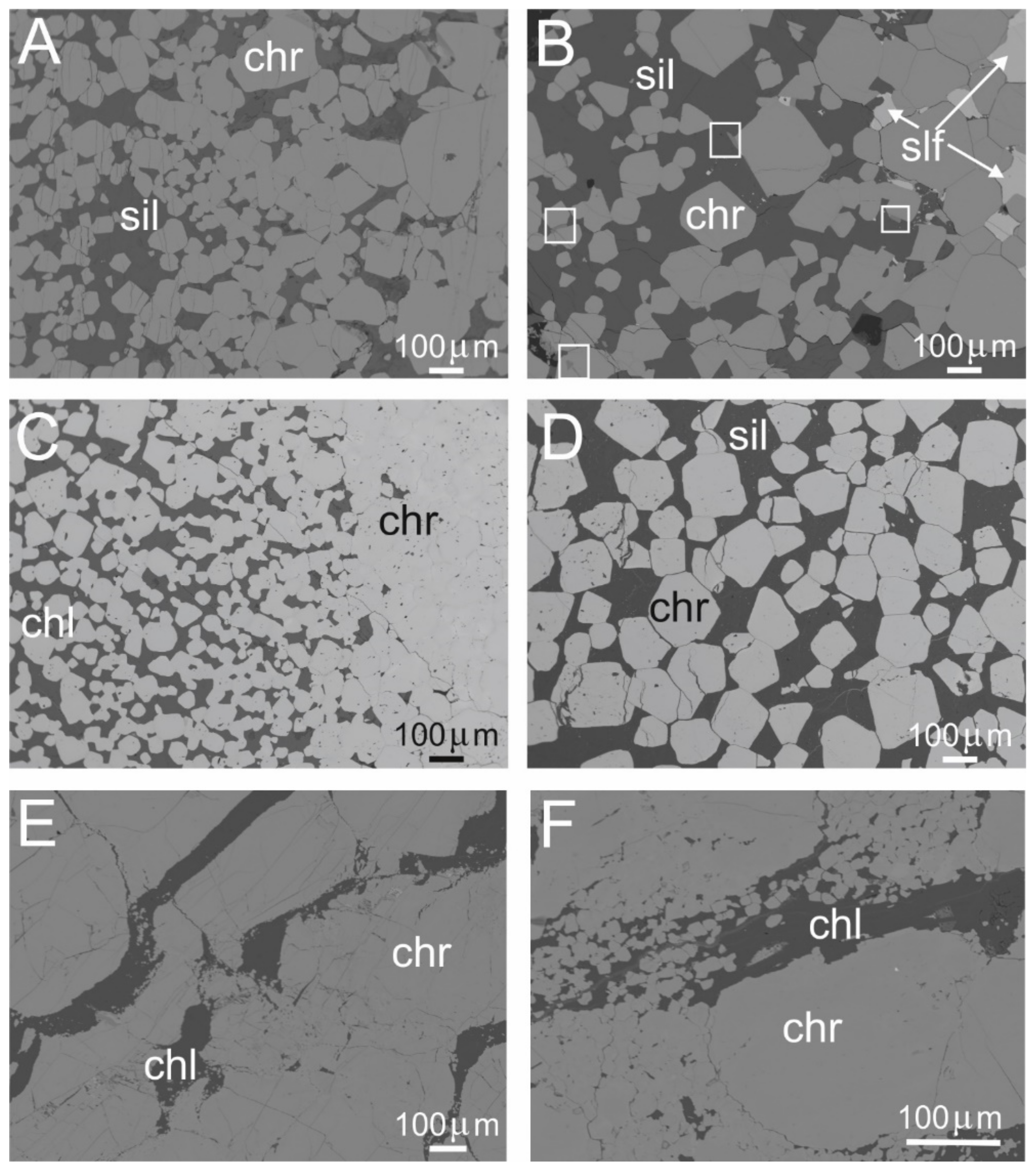
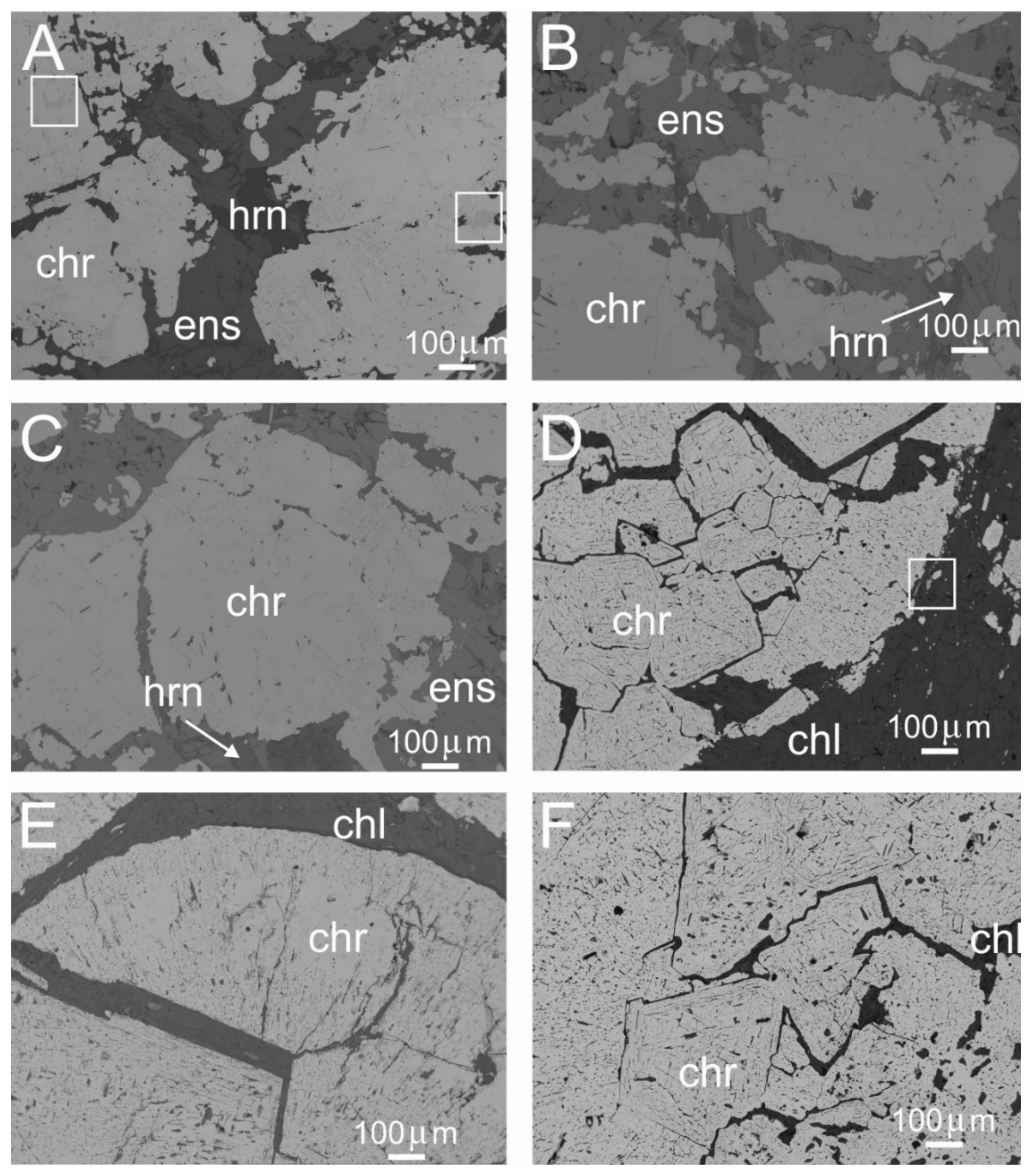
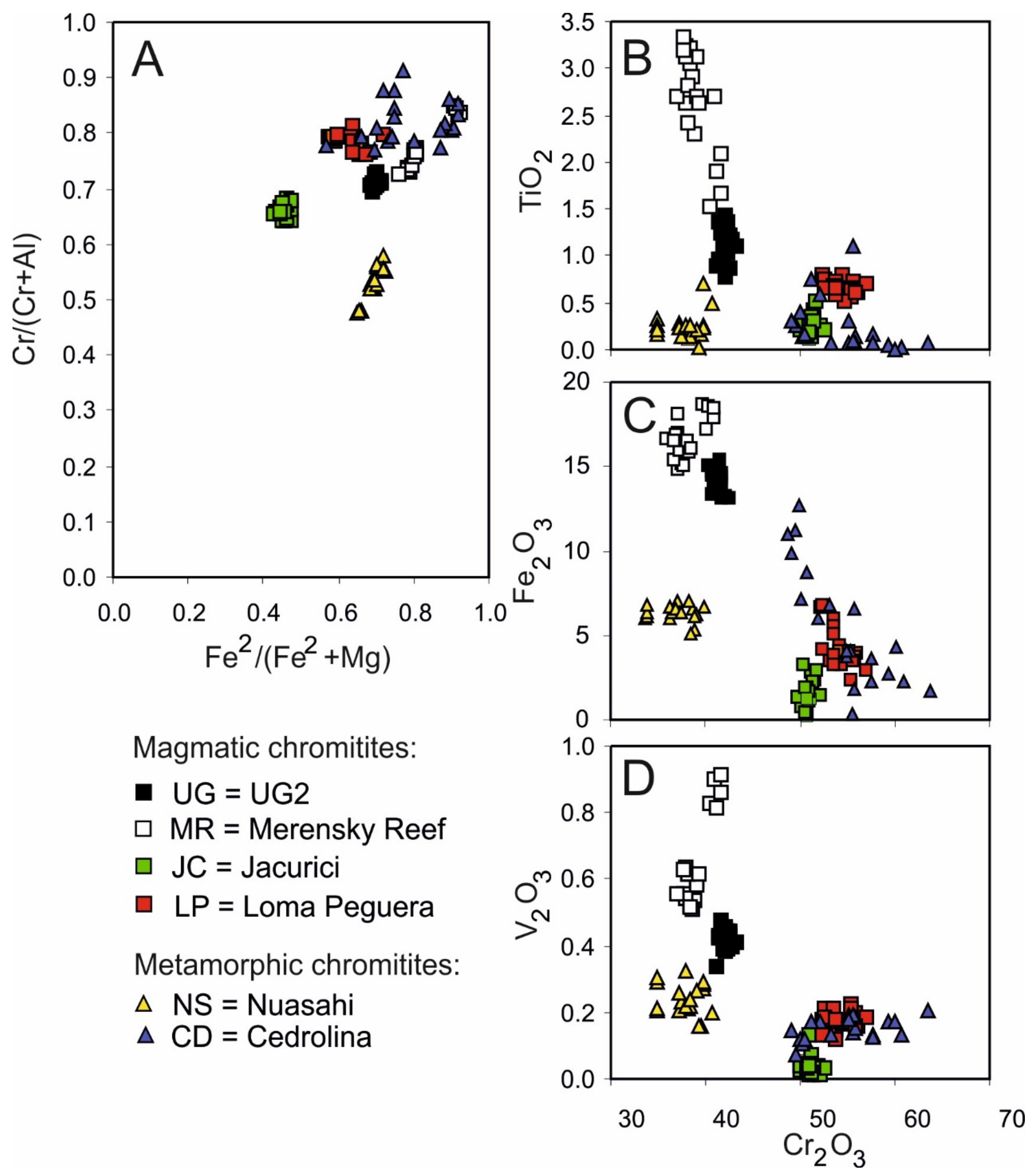
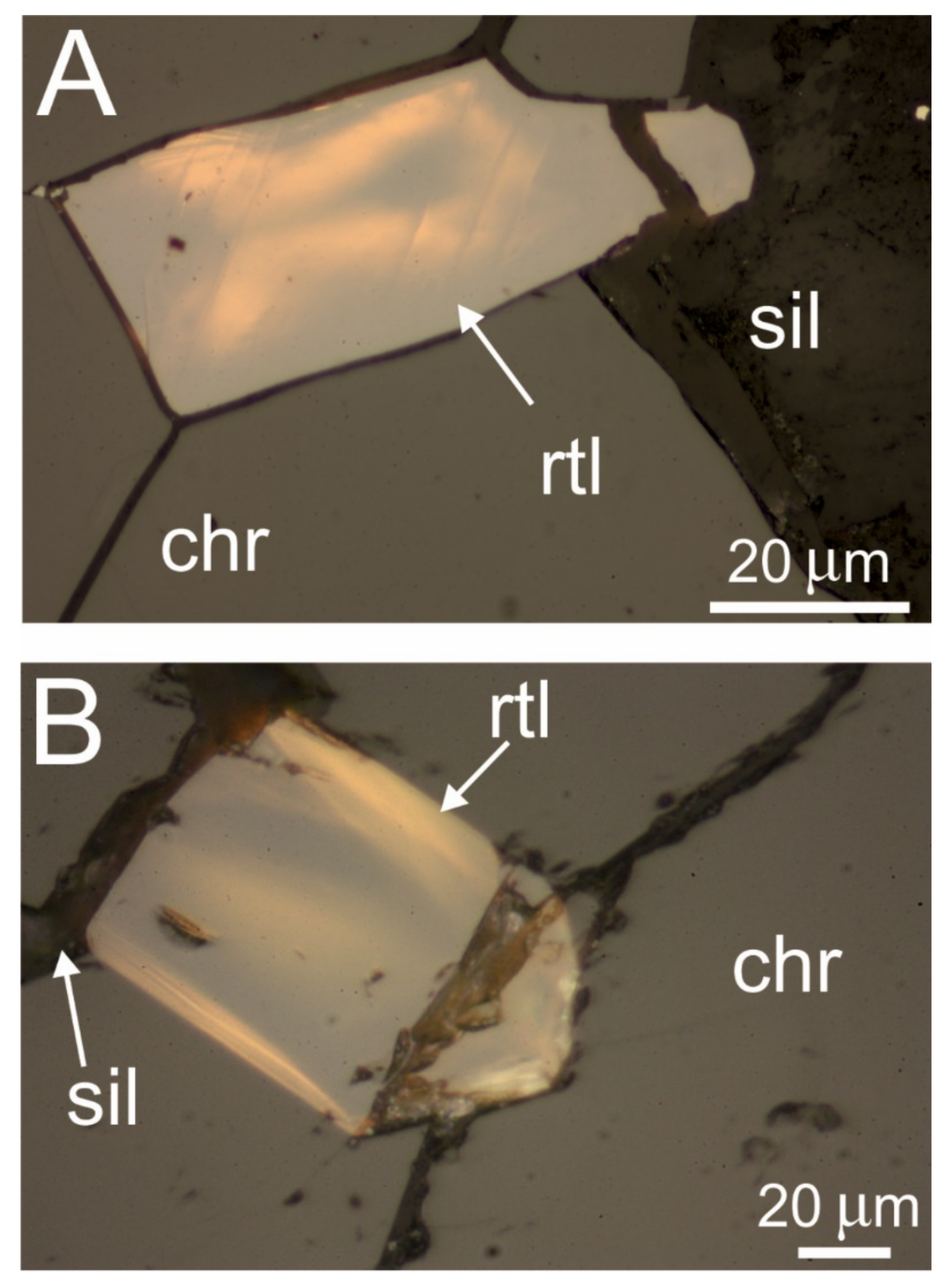
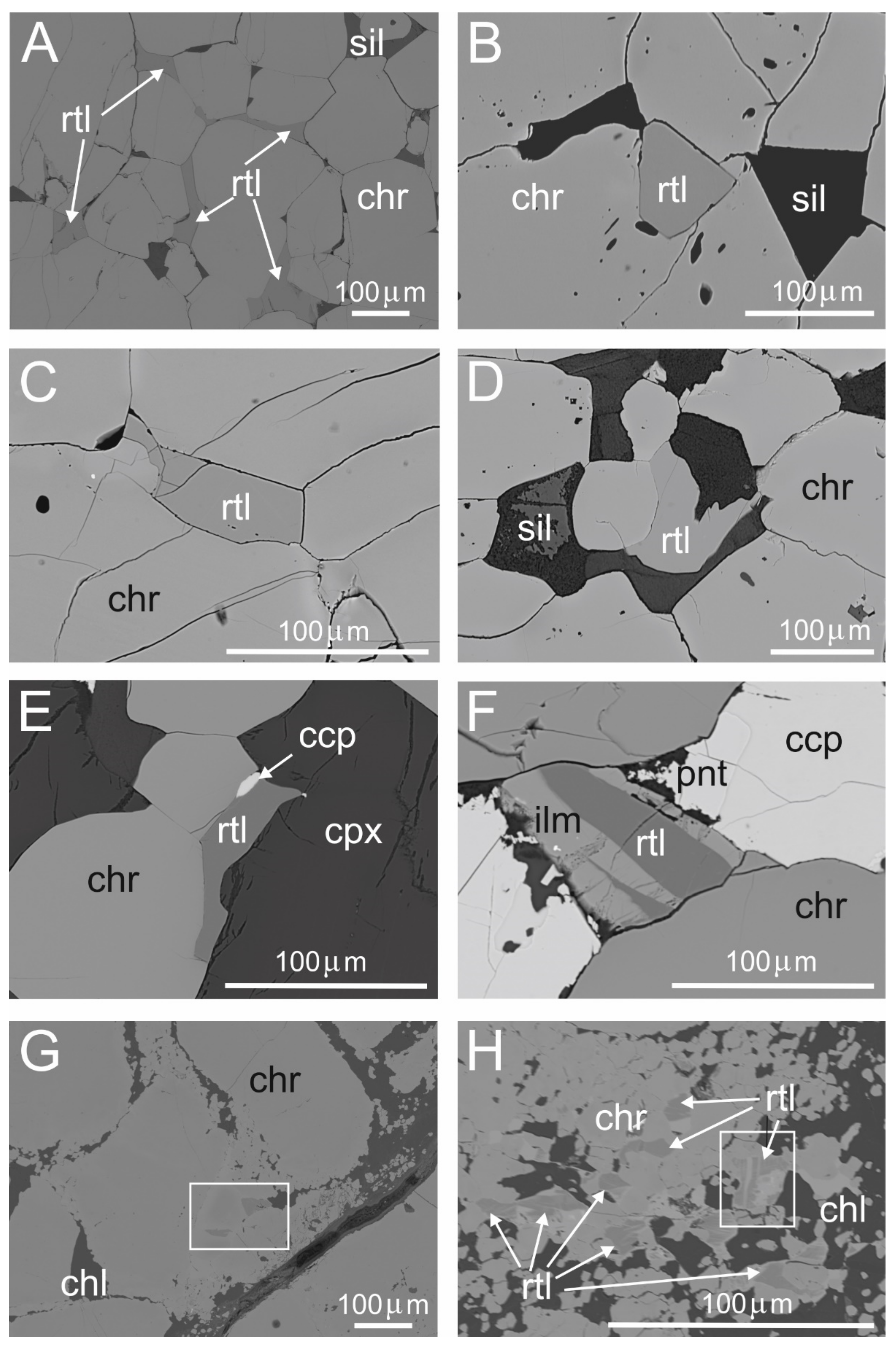
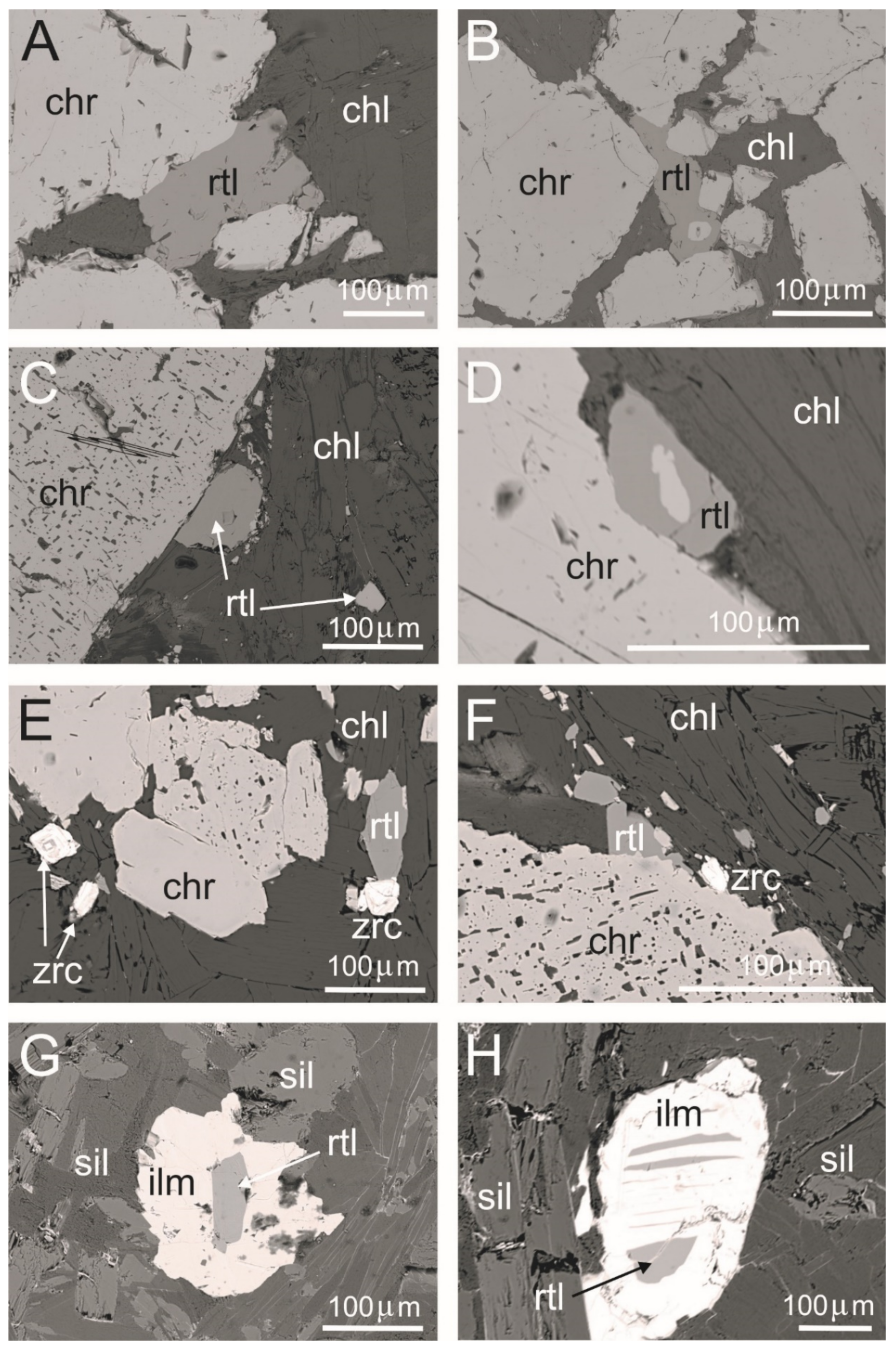
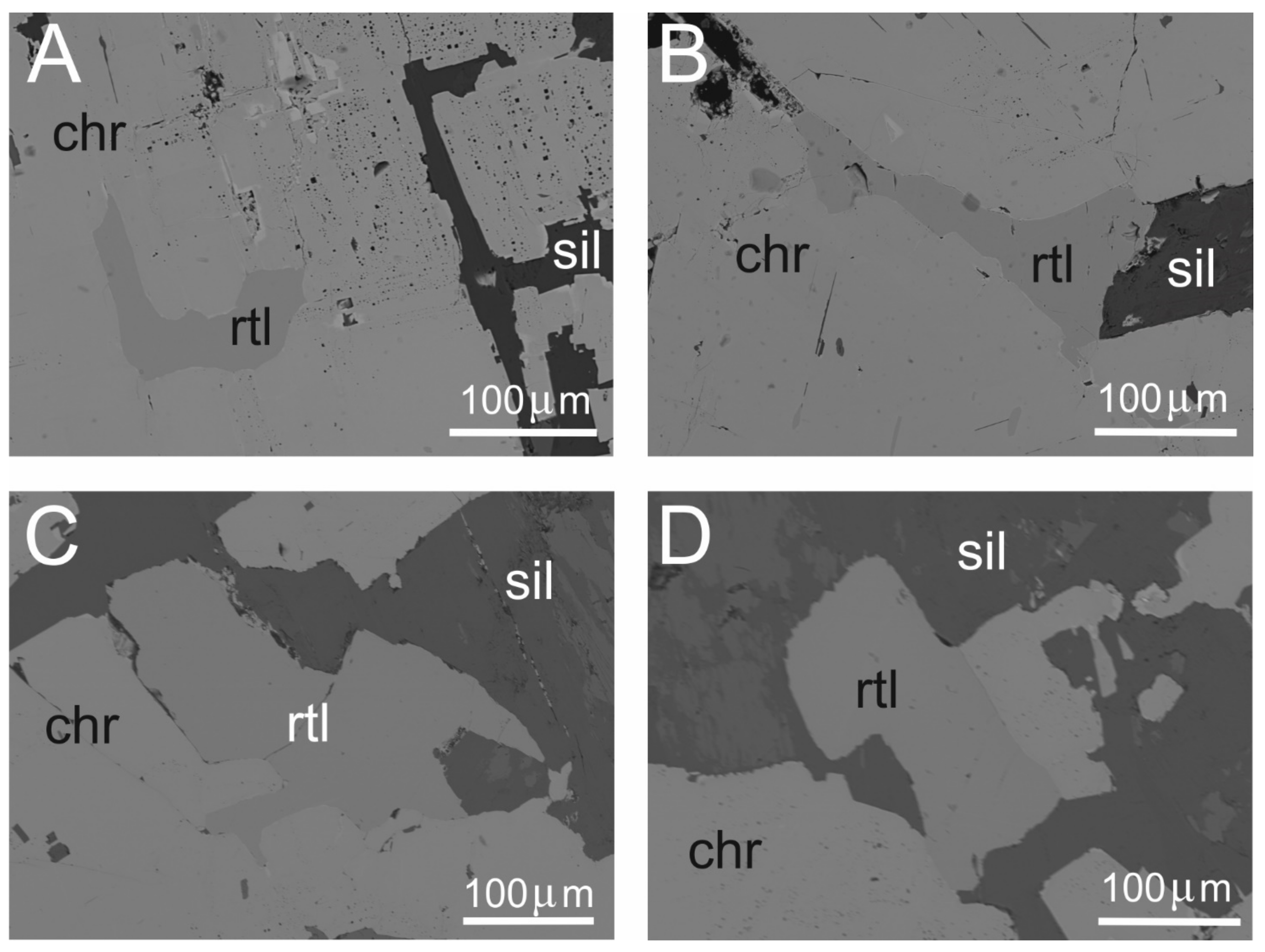
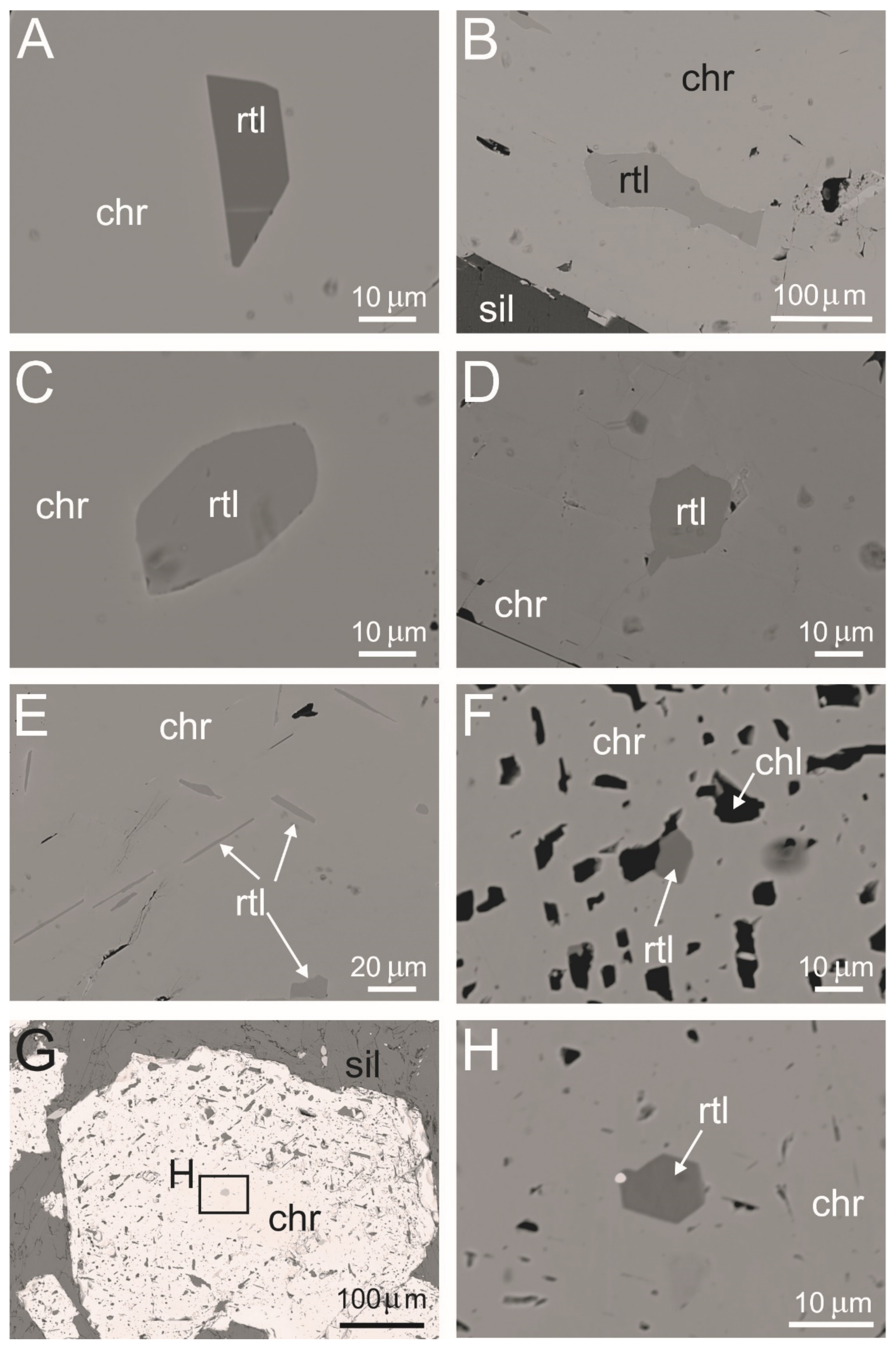
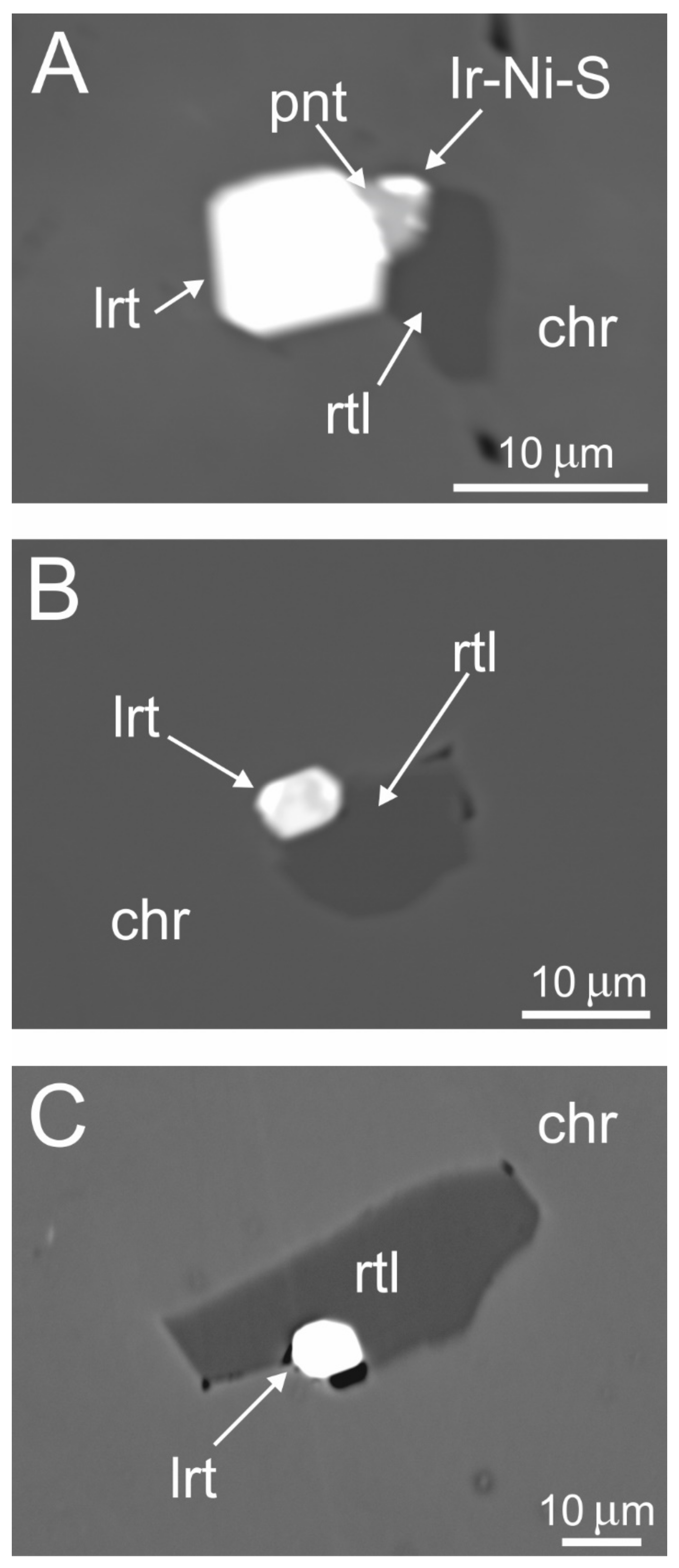

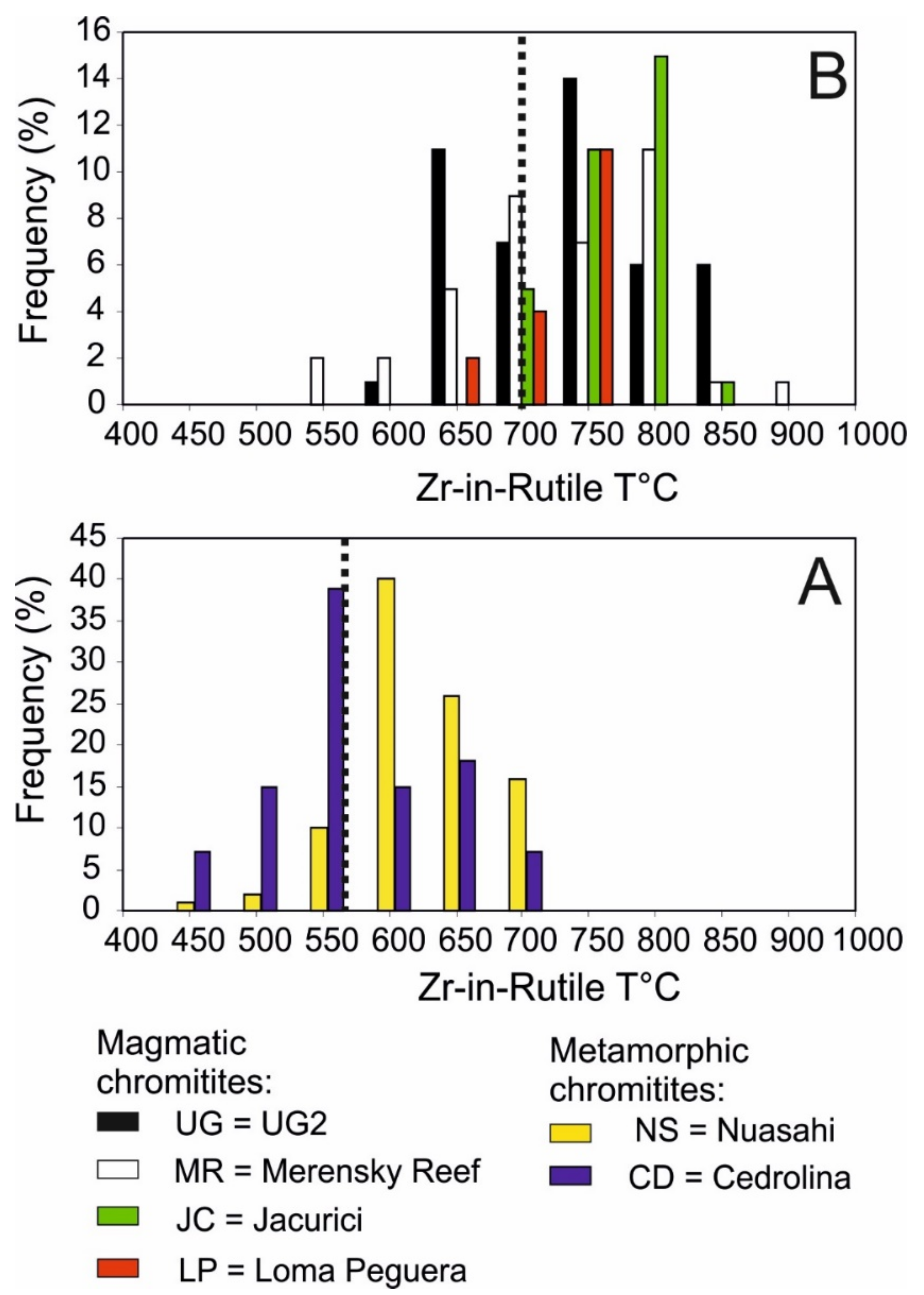
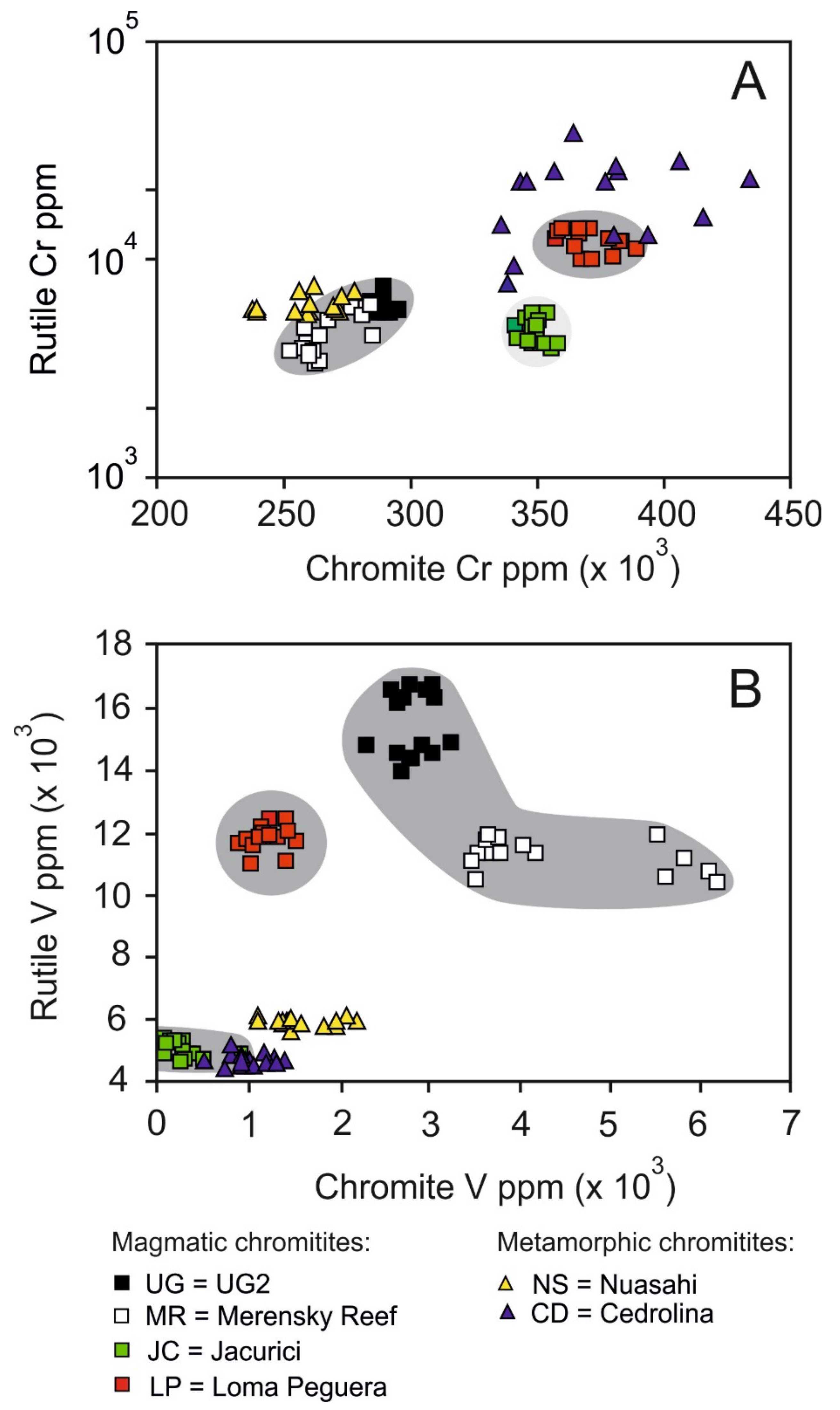
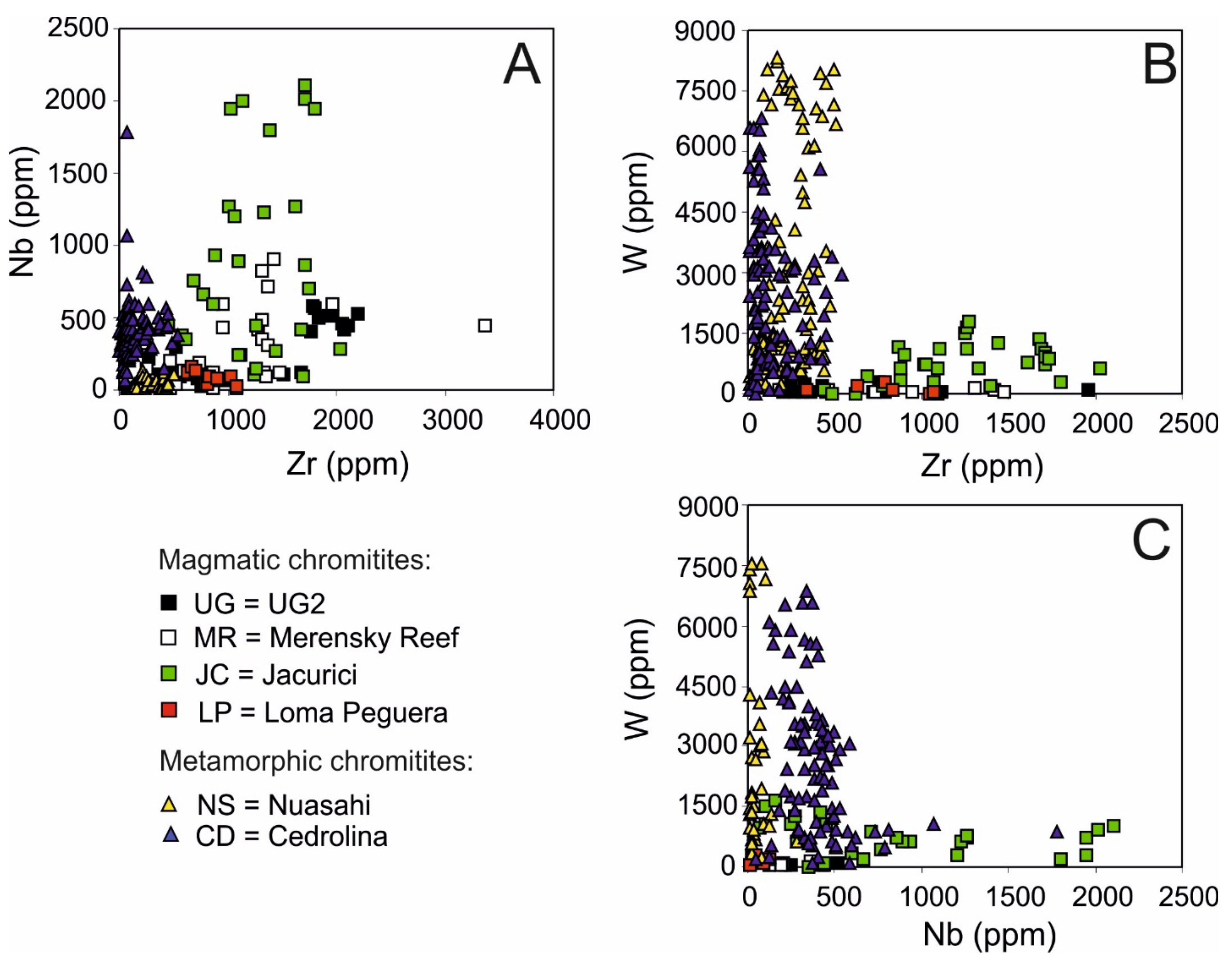
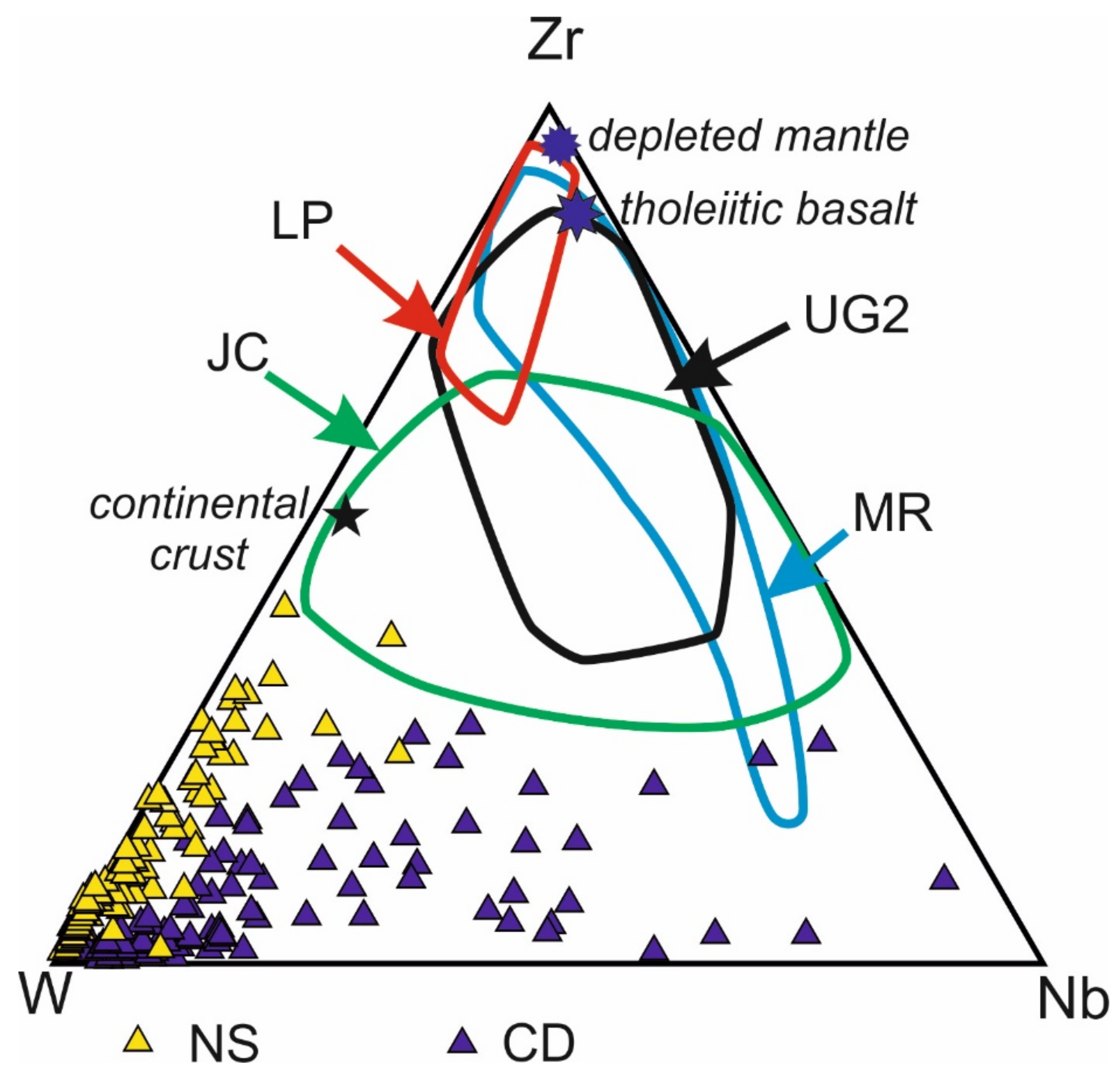
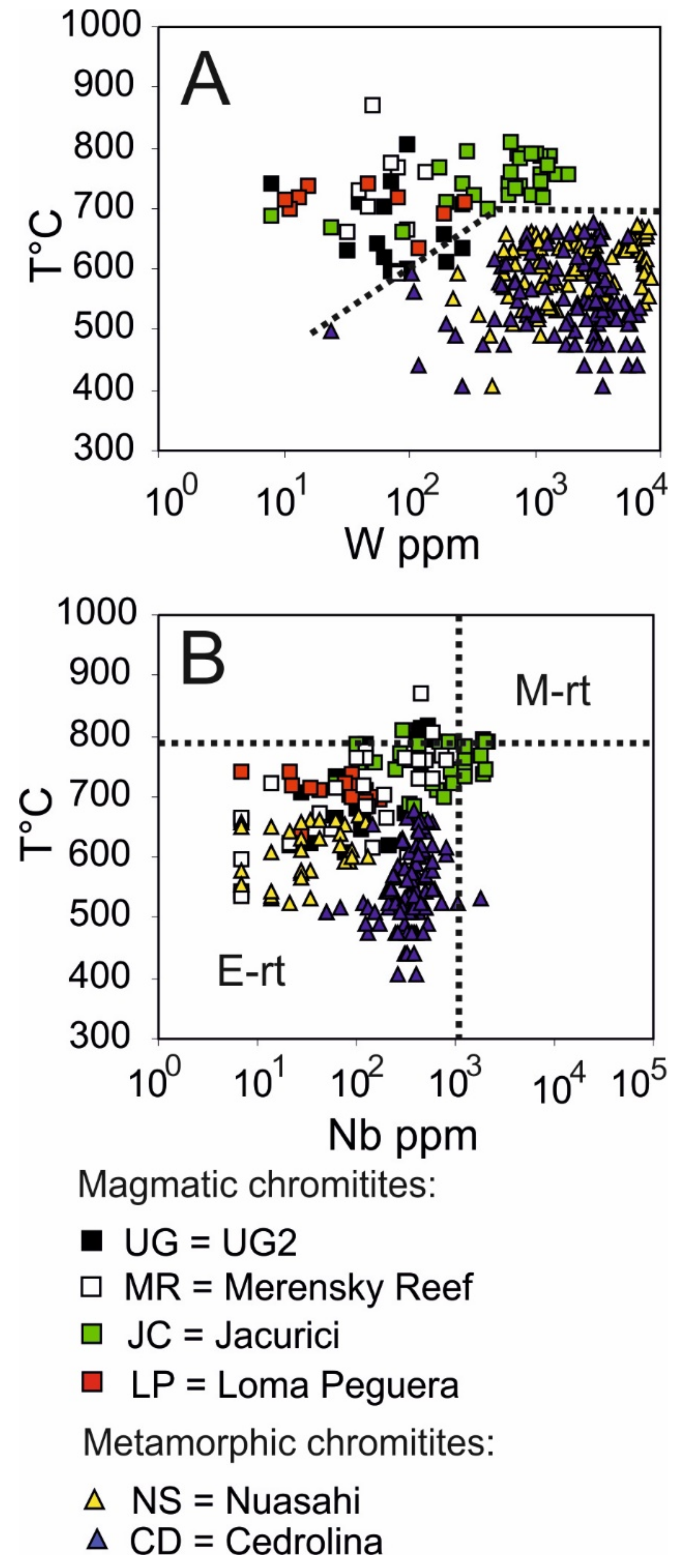
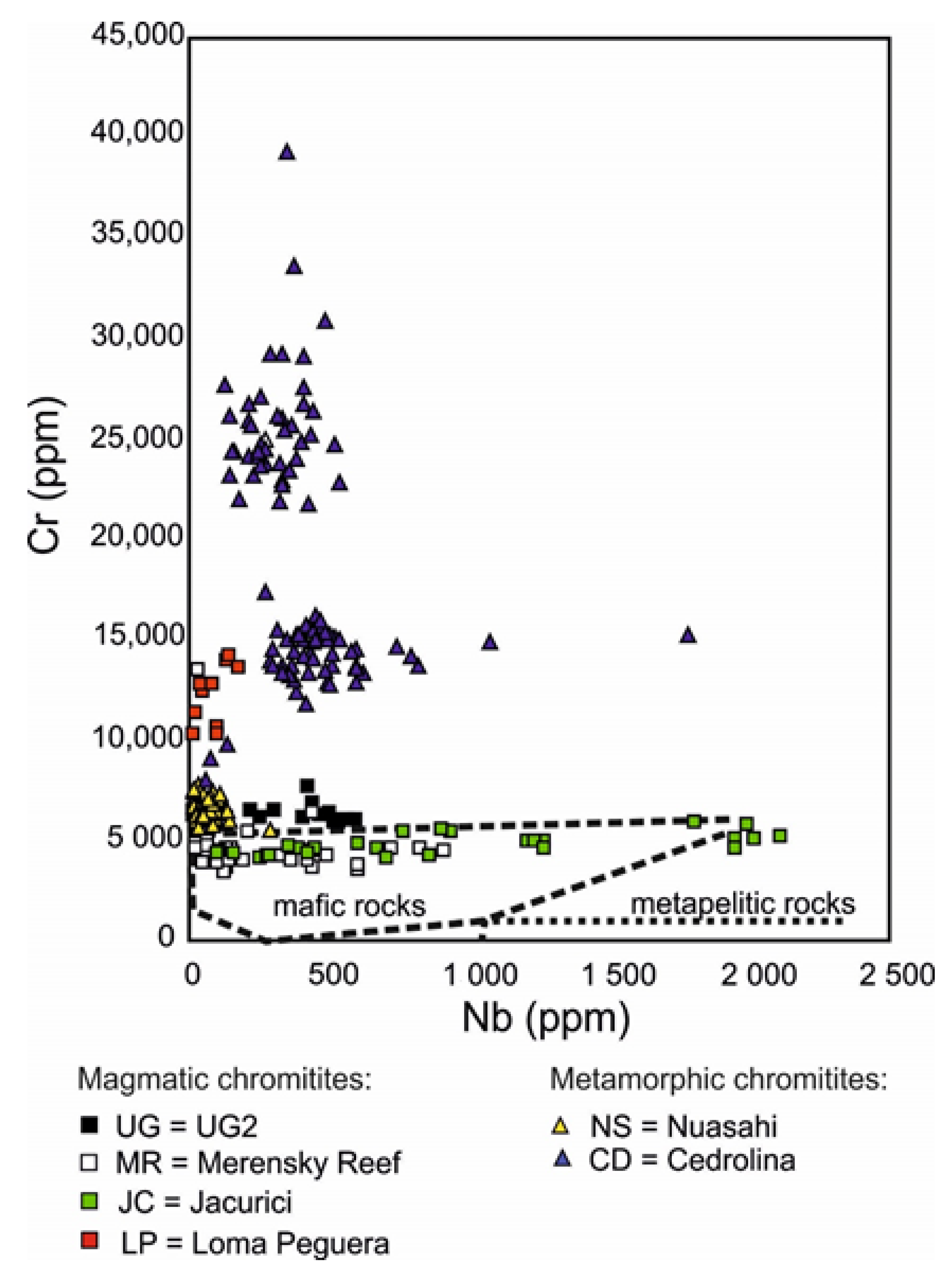
| Complex/Tectonic Setting/Deposit | Sample | Type/Size of Deposit | Ore Type/Alteration | Host Rock |
|---|---|---|---|---|
| UNMETAMORPHOSED | ||||
| Bushveld Complex (South Africa): Continental Layered Intrusion (Paleoproterozoic) | ||||
| W. Bushweld, Rustenburg underground section | ||||
| UG2 chromitite layer | UG2-A | chromitite layer 0.75 m thick top | Massive | pyroxenite, anorthosite |
| UG2-B | chromitite layer 0.75 m thick middle | Massive | pyroxenite, anorthosite | |
| Merensky Reef sulfide-PGE deposit | MR1 | reef top chromite-seam 0.3–0.8 cm thick | Massive to disseminated | pegmatoidal, feldspatic pyroxenite |
| MR2 | reef bottom chromite-seam 0.5–1.5 cm thick | Massive | pegmatoidal, feldspatic pyroxenite | |
| Jacurici Complex (Bahia State, Brazil): Intracratonic mafic-ultramafic sill (Paleoproterozoic) | ||||
| Ipuera Socò Prospect, drill core S1-1 45° | JC135 | chromitite layer 1.7 m thick | Massive, altered rims | serpentinized dunite |
| Varzea do Macaco-Teiù, drill coreT1-5 45° | JC148 | chromitite layer 4.5 m thick, top | Massive, altered rims | serpentinite + carbonate vein |
| JC150 | chromitite layer 4.5 m thick, middle | Massive, altered rims | serpentinite + carbonate vein | |
| Loma Caribe Peridotite Massif (Dominican Republic): Intraoceanic Mantle Tectonite Plume (Mesozoic) | ||||
| Loma Peguera Nickel mine (Bonao District) | LP4 | chromitite pod 0.30 m thick | Massive, altered rims | laterite weathered harzburgite |
| LP6 | chromitite pod 0.15 m thick | Massive, altered rims | laterite weathered harzburgite | |
| METAMORPHOSED | ||||
| Nuasahi Complex (Orissa, Eastern India): Intracratonic Layered Intrusion (Archean) | ||||
| S. Nuasahi, hanging wall Breccia Zone | NS9 | chromitite fragment in gabbro matrix | Massive altered | serpentinite |
| Cedrolina Complex (Goias state, Brazil): Pilar de Goiás greenstone belt (Paleoproterozoic) | ||||
| Cedrolina prospect, detrital blocks | CD100 | nudular chromitite (<0.5 cm) | Strongly weathered | talc-chlorite schist |
| CD105C | brecciated nodular chromitite (<1.0 cm) | Moderately weathered | talc-chlorite schist | |
| CD106D | nudular chromitite (<1.5 cm) | Slightly altered | talc-chlorite schist | |
| CD143 | Slightly altered | talc-chlorite schist | ||
| CD47A3 | brecciated nodular chromitite (<1.0 cm) | Intensely weathered | talc-chlorite schist | |
| Sample | SiO2 | TiO2 | Al2O3 | FeO | Fe2O3 | MgO | MnO | Cr2O3 | V2O3 | Total | Fe2# | Cr# | Al | Fe3 | Cr |
|---|---|---|---|---|---|---|---|---|---|---|---|---|---|---|---|
| Bushveld (UG2 chromitite layer) | |||||||||||||||
| UG2-1 | 0.00 | 0.89 | 11.70 | 24.68 | 14.71 | 6.03 | 0.39 | 41.16 | 0.34 | 99.89 | 0.70 | 0.70 | 0.470 | 0.38 | 1.11 |
| UG2-2 | 0.02 | 0.97 | 11.55 | 24.74 | 14.17 | 6.05 | 0.28 | 41.56 | 0.48 | 99.82 | 0.70 | 0.71 | 0.465 | 0.36 | 1.12 |
| UG2-3 | 0.01 | 1.14 | 11.32 | 24.44 | 13.88 | 6.21 | 0.35 | 41.75 | 0.39 | 99.49 | 0.69 | 0.71 | 0.457 | 0.36 | 1.13 |
| UG2-4 | 0.00 | 1.19 | 11.35 | 25.49 | 14.31 | 5.78 | 0.38 | 41.77 | 0.44 | 100.70 | 0.71 | 0.71 | 0.454 | 0.37 | 1.12 |
| UG2-5 | 0.00 | 1.17 | 11.62 | 24.59 | 13.70 | 6.29 | 0.39 | 42.01 | 0.41 | 100.18 | 0.69 | 0.71 | 0.465 | 0.35 | 1.13 |
| UG2-6 | 0.03 | 1.42 | 10.62 | 25.21 | 14.41 | 6.05 | 0.38 | 42.12 | 0.38 | 100.62 | 0.70 | 0.73 | 0.426 | 0.37 | 1.13 |
| UG2-7 | 0.01 | 0.78 | 12.39 | 24.82 | 14.08 | 6.23 | 0.41 | 42.19 | 0.45 | 101.36 | 0.69 | 0.70 | 0.489 | 0.35 | 1.12 |
| UG2-8 | 0.01 | 1.03 | 10.64 | 24.80 | 14.99 | 6.07 | 0.34 | 42.31 | 0.39 | 100.59 | 0.70 | 0.73 | 0.427 | 0.38 | 1.14 |
| UG2-9 | 0.01 | 1.35 | 10.44 | 25.06 | 14.31 | 6.03 | 0.33 | 42.35 | 0.40 | 100.29 | 0.70 | 0.73 | 0.420 | 0.37 | 1.14 |
| UG2-10 | 0.02 | 1.13 | 11.48 | 25.58 | 13.74 | 5.83 | 0.34 | 42.40 | 0.45 | 100.97 | 0.71 | 0.71 | 0.458 | 0.35 | 1.13 |
| UG2-11 | 0.01 | 1.22 | 11.61 | 24.90 | 12.87 | 6.16 | 0.40 | 42.52 | 0.45 | 100.14 | 0.69 | 0.71 | 0.465 | 0.33 | 1.14 |
| UG2-12 | 0.02 | 1.18 | 11.70 | 25.03 | 12.94 | 6.14 | 0.46 | 42.76 | 0.40 | 100.63 | 0.70 | 0.71 | 0.466 | 0.33 | 1.14 |
| UG2-13 | 0.00 | 1.10 | 11.62 | 25.13 | 12.87 | 6.07 | 0.34 | 43.18 | 0.41 | 100.72 | 0.70 | 0.71 | 0.463 | 0.33 | 1.15 |
| UG2-14 | 0.00 | 1.03 | 11.57 | 24.91 | 13.21 | 5.90 | 0.29 | 41.95 | 0.41 | 99.27 | 0.70 | 0.71 | 0.468 | 0.34 | 1.14 |
| UG2-15 | 0.03 | 1.23 | 11.13 | 25.08 | 14.06 | 5.90 | 0.38 | 41.61 | 0.43 | 99.85 | 0.70 | 0.71 | 0.449 | 0.36 | 1.13 |
| UG2-16 | 0.03 | 1.08 | 11.30 | 25.51 | 14.61 | 5.90 | 0.33 | 42.08 | 0.46 | 101.30 | 0.71 | 0.71 | 0.450 | 0.37 | 1.12 |
| UG2-17 | 0.07 | 0.96 | 11.80 | 24.48 | 13.13 | 6.01 | 0.41 | 41.41 | 0.42 | 98.68 | 0.70 | 0.70 | 0.479 | 0.34 | 1.13 |
| UG2-18 | 0.01 | 1.03 | 11.63 | 25.12 | 14.06 | 5.95 | 0.39 | 41.90 | 0.43 | 100.53 | 0.70 | 0.71 | 0.465 | 0.36 | 1.12 |
| UG2-19 | 0.00 | 0.88 | 11.68 | 25.18 | 14.00 | 5.90 | 0.38 | 42.45 | 0.43 | 100.89 | 0.71 | 0.71 | 0.465 | 0.36 | 1.14 |
| UG2-20 | 0.00 | 1.36 | 10.66 | 24.91 | 14.39 | 5.95 | 0.42 | 41.45 | 0.43 | 99.57 | 0.70 | 0.72 | 0.432 | 0.37 | 1.13 |
| UG2-Average | 0.01 | 1.11 | 11.39 | 24.98 | 13.92 | 6.02 | 0.37 | 42.05 | 0.42 | 100.28 | 0.70 | 0.71 | 0.46 | 0.36 | 1.13 |
| Bushveld (Merensky Reef) | |||||||||||||||
| MR1-1 | 0.02 | 2.71 | 4.93 | 31.87 | 16.75 | 1.85 | 0.40 | 40.94 | 0.90 | 100.37 | 0.91 | 0.85 | 0.211 | 0.46 | 1.18 |
| MR1-2 | 0.01 | 1.54 | 5.40 | 31.05 | 18.14 | 1.52 | 0.47 | 40.53 | 0.83 | 99.50 | 0.92 | 0.83 | 0.234 | 0.50 | 1.18 |
| MR1-3 | 0.01 | 1.91 | 5.36 | 31.96 | 18.10 | 1.49 | 0.47 | 41.08 | 0.82 | 101.19 | 0.92 | 0.84 | 0.228 | 0.49 | 1.17 |
| MR1-4 | 0.04 | 2.10 | 5.06 | 31.84 | 17.46 | 1.69 | 0.38 | 41.60 | 0.91 | 101.08 | 0.91 | 0.85 | 0.215 | 0.47 | 1.19 |
| MR1-5 | 0.03 | 1.68 | 5.15 | 31.16 | 17.94 | 1.73 | 0.47 | 41.69 | 0.86 | 100.71 | 0.91 | 0.84 | 0.220 | 0.49 | 1.19 |
| MR2-1 | 0.03 | 3.25 | 9.24 | 28.71 | 14.48 | 4.50 | 0.33 | 37.95 | 0.54 | 99.03 | 0.78 | 0.73 | 0.384 | 0.38 | 1.06 |
| MR2-2 | 0.01 | 3.23 | 9.27 | 29.02 | 14.80 | 4.42 | 0.43 | 38.45 | 0.52 | 100.16 | 0.79 | 0.74 | 0.381 | 0.39 | 1.06 |
| MR2-3 | 0.02 | 2.30 | 9.20 | 27.96 | 15.56 | 4.35 | 0.37 | 38.72 | 0.54 | 99.02 | 0.78 | 0.74 | 0.382 | 0.41 | 1.08 |
| MR2-4 | 0.00 | 2.90 | 9.41 | 28.72 | 14.73 | 4.44 | 0.32 | 38.71 | 0.51 | 99.75 | 0.78 | 0.73 | 0.388 | 0.39 | 1.07 |
| MR2-5 | 0.00 | 3.33 | 9.33 | 29.11 | 15.02 | 4.39 | 0.36 | 37.64 | 0.56 | 99.74 | 0.79 | 0.73 | 0.385 | 0.40 | 1.04 |
| MR2-6 | 0.05 | 2.64 | 9.14 | 28.40 | 16.29 | 4.45 | 0.35 | 37.87 | 0.54 | 99.73 | 0.78 | 0.74 | 0.377 | 0.43 | 1.05 |
| MR2-7 | 0.00 | 3.04 | 8.88 | 29.08 | 15.58 | 4.26 | 0.37 | 38.31 | 0.52 | 100.04 | 0.79 | 0.74 | 0.366 | 0.41 | 1.06 |
| MR2-8 | 0.78 | 2.70 | 9.27 | 28.48 | 16.25 | 5.11 | 0.56 | 36.92 | 0.56 | 100.62 | 0.76 | 0.73 | 0.376 | 0.42 | 1.01 |
| MR2-9 | 0.03 | 2.81 | 8.07 | 29.11 | 16.53 | 3.86 | 0.41 | 38.12 | 0.62 | 99.56 | 0.81 | 0.76 | 0.337 | 0.44 | 1.07 |
| MR2-10 | 0.06 | 2.71 | 8.29 | 28.90 | 15.51 | 4.06 | 0.35 | 39.17 | 0.60 | 99.65 | 0.80 | 0.76 | 0.345 | 0.41 | 1.09 |
| MR2-11 | 0.06 | 3.13 | 7.68 | 29.57 | 16.11 | 3.98 | 0.34 | 38.99 | 0.58 | 100.45 | 0.81 | 0.77 | 0.318 | 0.43 | 1.08 |
| MR2-12 | 0.00 | 2.43 | 7.57 | 28.41 | 17.57 | 3.92 | 0.34 | 38.13 | 0.62 | 98.99 | 0.80 | 0.77 | 0.319 | 0.47 | 1.08 |
| MR2-13 | 0.00 | 3.14 | 7.78 | 29.07 | 16.42 | 3.98 | 0.39 | 37.82 | 0.64 | 99.23 | 0.80 | 0.77 | 0.326 | 0.44 | 1.06 |
| MR2-14 | 0.00 | 3.19 | 8.03 | 29.19 | 16.14 | 4.01 | 0.33 | 37.73 | 0.63 | 99.25 | 0.80 | 0.76 | 0.336 | 0.43 | 1.06 |
| MR2-15 | 0.02 | 2.62 | 8.08 | 28.93 | 15.68 | 3.91 | 0.39 | 39.34 | 0.62 | 99.59 | 0.81 | 0.77 | 0.337 | 0.42 | 1.10 |
| MR-Average | 0.06 | 2.67 | 7.76 | 29.53 | 16.25 | 3.60 | 0.39 | 38.98 | 0.64 | 99.88 | 0.82 | 0.77 | 0.32 | 0.43 | 1.09 |
| Jacurici (ultramafic sill) | |||||||||||||||
| JC135-2 | 0.03 | 0.20 | 18.51 | 17.08 | 1.61 | 11.50 | 0.18 | 50.00 | 0.02 | 99.15 | 0.45 | 0.64 | 0.694 | 0.04 | 1.26 |
| JC135-5 | 0.00 | 0.27 | 18.77 | 17.30 | 1.12 | 11.50 | 0.23 | 50.55 | 0.05 | 99.78 | 0.46 | 0.64 | 0.699 | 0.03 | 1.26 |
| JC135-6 | 0.01 | 0.24 | 18.75 | 17.26 | 0.77 | 11.49 | 0.23 | 50.95 | 0.01 | 99.71 | 0.46 | 0.65 | 0.698 | 0.02 | 1.27 |
| JC135-7 | 0.03 | 0.32 | 18.64 | 17.74 | 0.54 | 11.32 | 0.23 | 51.13 | 0.06 | 100.01 | 0.47 | 0.65 | 0.694 | 0.01 | 1.28 |
| JC135-10 | 0.04 | 0.18 | 18.94 | 17.83 | 0.64 | 11.23 | 0.23 | 50.96 | 0.13 | 100.20 | 0.47 | 0.64 | 0.704 | 0.02 | 1.27 |
| JC135-13 | 0.01 | 0.26 | 18.79 | 17.03 | 1.64 | 11.65 | 0.15 | 50.02 | 0.04 | 99.58 | 0.45 | 0.64 | 0.700 | 0.04 | 1.25 |
| JC135-15 | 0.13 | 0.27 | 18.64 | 17.64 | 0.80 | 11.47 | 0.23 | 50.95 | 0.03 | 100.16 | 0.46 | 0.65 | 0.692 | 0.02 | 1.27 |
| JC148-2 | 0.00 | 0.34 | 17.39 | 17.86 | 1.98 | 11.21 | 0.19 | 51.38 | 0.01 | 100.36 | 0.47 | 0.66 | 0.650 | 0.05 | 1.29 |
| JC148-7 | 0.03 | 0.27 | 16.21 | 17.34 | 2.57 | 11.25 | 0.24 | 51.84 | 0.04 | 99.78 | 0.46 | 0.68 | 0.611 | 0.06 | 1.31 |
| JC148-9 | 0.00 | 0.43 | 16.83 | 17.57 | 3.04 | 11.47 | 0.23 | 51.35 | 0.02 | 100.93 | 0.46 | 0.67 | 0.626 | 0.07 | 1.28 |
| JC148-11 | 0.00 | 0.15 | 17.13 | 16.80 | 3.51 | 11.67 | 0.21 | 50.71 | 0.03 | 100.20 | 0.45 | 0.67 | 0.640 | 0.08 | 1.27 |
| JC148-12 | 0.01 | 0.25 | 16.66 | 18.03 | 3.09 | 11.14 | 0.32 | 52.03 | 0.01 | 101.54 | 0.48 | 0.68 | 0.618 | 0.07 | 1.30 |
| JC148-14 | 0.00 | 0.53 | 16.57 | 17.99 | 2.53 | 11.19 | 0.22 | 51.71 | 0.04 | 100.78 | 0.47 | 0.68 | 0.619 | 0.06 | 1.30 |
| JC150-1 | 0.02 | 0.21 | 17.07 | 16.93 | 1.71 | 11.64 | 0.30 | 52.46 | 0.04 | 100.38 | 0.45 | 0.67 | 0.636 | 0.04 | 1.31 |
| JC150-2 | 0.18 | 0.34 | 17.65 | 16.72 | 1.38 | 11.91 | 0.27 | 51.23 | 0.07 | 99.76 | 0.44 | 0.66 | 0.659 | 0.03 | 1.28 |
| JC150-3 | 0.01 | 0.12 | 17.90 | 16.62 | 2.18 | 11.71 | 0.27 | 51.01 | 0.05 | 99.87 | 0.44 | 0.66 | 0.668 | 0.05 | 1.28 |
| JC150-4 | 0.05 | 0.31 | 17.76 | 17.24 | 1.54 | 11.60 | 0.22 | 51.44 | 0.04 | 100.19 | 0.45 | 0.66 | 0.661 | 0.04 | 1.28 |
| JC150-10 | 0.02 | 0.14 | 17.95 | 16.32 | 1.95 | 12.01 | 0.28 | 51.22 | 0.02 | 99.90 | 0.43 | 0.66 | 0.668 | 0.05 | 1.28 |
| JC150-13 | 0.00 | 0.16 | 17.95 | 16.14 | 2.18 | 12.03 | 0.29 | 50.79 | 0.03 | 99.57 | 0.43 | 0.66 | 0.670 | 0.05 | 1.27 |
| JC150-15 | 0.03 | 0.19 | 17.58 | 16.60 | 1.55 | 11.65 | 0.23 | 50.96 | 0.04 | 98.83 | 0.44 | 0.66 | 0.663 | 0.04 | 1.29 |
| JC-Average | 0.03 | 0.26 | 17.78 | 17.20 | 1.82 | 11.53 | 0.24 | 51.13 | 0.04 | 100.04 | 0.46 | 0.66 | 0.66 | 0.04 | 1.28 |
| Loma Peguera (chromitite pod in mantle tectonite) | |||||||||||||||
| LP4-1 | 0.00 | 0.76 | 9.68 | 20.91 | 6.74 | 8.25 | 0.39 | 52.31 | 0.18 | 99.22 | 0.59 | 0.78 | 0.387 | 0.17 | 1.40 |
| LP4-2 | 0.00 | 0.80 | 9.60 | 21.06 | 6.67 | 8.13 | 0.39 | 52.44 | 0.13 | 99.22 | 0.59 | 0.79 | 0.384 | 0.17 | 1.41 |
| LP4-3 | 0.00 | 0.76 | 9.50 | 20.72 | 6.81 | 8.28 | 0.40 | 52.61 | 0.21 | 99.29 | 0.58 | 0.79 | 0.380 | 0.17 | 1.41 |
| LP4-4 | 0.00 | 0.80 | 9.46 | 22.70 | 4.57 | 7.28 | 0.39 | 54.31 | 0.17 | 99.68 | 0.64 | 0.79 | 0.379 | 0.12 | 1.46 |
| LP4-5 | 0.00 | 0.72 | 9.31 | 21.80 | 6.02 | 7.41 | 0.32 | 53.66 | 0.15 | 99.38 | 0.62 | 0.79 | 0.373 | 0.15 | 1.44 |
| LP4-6 | 0.00 | 0.69 | 9.30 | 22.15 | 5.57 | 7.31 | 0.37 | 53.66 | 0.15 | 99.19 | 0.63 | 0.79 | 0.374 | 0.14 | 1.45 |
| LP4-7 | 0.00 | 0.61 | 8.56 | 22.33 | 4.11 | 7.19 | 0.39 | 56.12 | 0.16 | 99.46 | 0.64 | 0.81 | 0.345 | 0.11 | 1.52 |
| LP4-8 | 0.00 | 0.74 | 9.44 | 22.36 | 5.24 | 7.30 | 0.36 | 53.70 | 0.17 | 99.31 | 0.63 | 0.79 | 0.380 | 0.13 | 1.45 |
| LP4-9 | 0.00 | 0.73 | 10.16 | 22.73 | 2.57 | 7.33 | 0.37 | 55.55 | 0.17 | 99.63 | 0.63 | 0.79 | 0.406 | 0.07 | 1.49 |
| LP4-10 | 0.00 | 0.63 | 9.94 | 22.62 | 4.19 | 7.20 | 0.30 | 54.33 | 0.17 | 99.37 | 0.64 | 0.79 | 0.398 | 0.11 | 1.46 |
| LP4-11 | 0.00 | 0.56 | 9.71 | 20.48 | 4.23 | 8.50 | 0.37 | 55.31 | 0.23 | 99.39 | 0.57 | 0.79 | 0.386 | 0.11 | 1.48 |
| LP6-1 | 0.00 | 0.67 | 9.68 | 20.74 | 3.84 | 8.54 | 0.40 | 55.91 | 0.20 | 99.98 | 0.58 | 0.79 | 0.383 | 0.10 | 1.48 |
| LP6-2 | 0.00 | 0.63 | 9.58 | 20.74 | 4.17 | 8.35 | 0.44 | 55.30 | 0.21 | 99.42 | 0.58 | 0.79 | 0.382 | 0.11 | 1.48 |
| LP6-3 | 0.00 | 0.70 | 9.58 | 21.42 | 3.16 | 8.14 | 0.40 | 56.89 | 0.18 | 100.46 | 0.60 | 0.80 | 0.378 | 0.08 | 1.51 |
| LP6-4 | 0.00 | 0.69 | 11.24 | 23.34 | 3.64 | 6.97 | 0.35 | 53.43 | 0.21 | 99.85 | 0.65 | 0.76 | 0.447 | 0.09 | 1.43 |
| LP6-5 | 0.00 | 0.52 | 10.28 | 23.45 | 3.50 | 6.72 | 0.39 | 54.58 | 0.17 | 99.61 | 0.66 | 0.78 | 0.412 | 0.09 | 1.47 |
| LP6-6 | 0.00 | 0.66 | 10.86 | 24.28 | 4.29 | 6.30 | 0.32 | 52.65 | 0.19 | 99.54 | 0.68 | 0.76 | 0.436 | 0.11 | 1.42 |
| LP6-7 | 0.00 | 0.58 | 10.90 | 22.64 | 3.98 | 7.24 | 0.35 | 53.68 | 0.18 | 99.54 | 0.64 | 0.77 | 0.434 | 0.10 | 1.43 |
| LP6-8 | 0.00 | 0.61 | 9.44 | 25.54 | 3.64 | 5.62 | 0.35 | 55.71 | 0.16 | 101.07 | 0.72 | 0.80 | 0.378 | 0.09 | 1.50 |
| LP6-9 | 0.00 | 0.67 | 11.17 | 24.20 | 3.51 | 6.62 | 0.32 | 53.81 | 0.12 | 100.42 | 0.67 | 0.76 | 0.443 | 0.09 | 1.43 |
| LP-Average | 0.00 | 0.68 | 9.87 | 22.31 | 4.52 | 7.43 | 0.37 | 54.30 | 0.18 | 99.65 | 0.63 | 0.79 | 0.39 | 0.12 | 1.46 |
| Nuasahi (chromitite fragment Breccia Zone) | |||||||||||||||
| NS9-1 | 0.02 | 0.13 | 22.35 | 25.44 | 6.64 | 6.34 | 0.33 | 38.09 | 0.21 | 99.54 | 0.69 | 0.53 | 0.854 | 0.16 | 0.98 |
| NS9-10 | 0.00 | 0.13 | 22.69 | 25.32 | 6.86 | 6.53 | 0.33 | 37.95 | 0.32 | 100.13 | 0.69 | 0.53 | 0.861 | 0.17 | 0.97 |
| NS9-11 ** | 0.05 | 0.32 | 25.35 | 24.70 | 6.09 | 7.09 | 0.30 | 34.80 | 0.29 | 98.99 | 0.66 | 0.48 | 0.956 | 0.15 | 0.88 |
| NS9-12 ** | 0.02 | 0.25 | 25.44 | 24.63 | 6.11 | 7.11 | 0.26 | 34.98 | 0.20 | 99.00 | 0.66 | 0.48 | 0.958 | 0.15 | 0.88 |
| NS9-13 ** | 0.00 | 0.22 | 22.13 | 25.47 | 7.05 | 6.34 | 0.28 | 38.03 | 0.21 | 99.73 | 0.69 | 0.54 | 0.845 | 0.17 | 0.97 |
| NS9-14 ** | 0.00 | 0.18 | 25.86 | 24.43 | 6.41 | 7.34 | 0.40 | 34.99 | 0.21 | 99.82 | 0.65 | 0.48 | 0.964 | 0.15 | 0.88 |
| NS9-15 ** | 0.00 | 0.25 | 21.80 | 26.68 | 5.39 | 5.60 | 0.36 | 39.77 | 0.27 | 100.13 | 0.73 | 0.55 | 0.835 | 0.13 | 1.02 |
| NS9-15bis | 0.02 | 0.16 | 20.87 | 25.60 | 6.63 | 6.07 | 0.31 | 39.56 | 0.16 | 99.38 | 0.70 | 0.56 | 0.804 | 0.16 | 1.02 |
| NS9-16 ** | 0.00 | 0.22 | 25.21 | 24.54 | 6.85 | 7.19 | 0.27 | 34.96 | 0.31 | 99.54 | 0.66 | 0.48 | 0.946 | 0.16 | 0.88 |
| NS9-17 | 0.01 | 0.29 | 23.17 | 25.56 | 6.09 | 6.34 | 0.28 | 37.23 | 0.20 | 99.17 | 0.69 | 0.52 | 0.884 | 0.15 | 0.95 |
| NS9-19 ** | 0.01 | 0.04 | 23.17 | 25.70 | 5.23 | 6.31 | 0.37 | 39.38 | 0.16 | 100.35 | 0.70 | 0.53 | 0.875 | 0.13 | 1.00 |
| NS9-20 ** | 0.03 | 0.49 | 19.86 | 26.47 | 6.71 | 5.85 | 0.28 | 40.67 | 0.20 | 100.55 | 0.72 | 0.58 | 0.762 | 0.16 | 1.05 |
| NS9-21 | 0.00 | 0.13 | 22.84 | 25.61 | 6.37 | 6.36 | 0.27 | 38.28 | 0.22 | 100.08 | 0.69 | 0.53 | 0.866 | 0.15 | 0.97 |
| NS9-26 | 0.00 | 0.15 | 23.04 | 25.28 | 6.37 | 6.40 | 0.31 | 37.39 | 0.23 | 99.18 | 0.69 | 0.52 | 0.880 | 0.16 | 0.96 |
| NS9-29 | 0.00 | 0.23 | 21.28 | 26.48 | 6.23 | 5.72 | 0.38 | 39.88 | 0.29 | 100.49 | 0.72 | 0.56 | 0.814 | 0.15 | 1.02 |
| NS9-4 ** | 0.00 | 0.71 | 20.53 | 25.86 | 6.13 | 6.24 | 0.33 | 39.82 | 0.29 | 99.91 | 0.70 | 0.57 | 0.789 | 0.15 | 1.03 |
| NS9-6 ** | 0.00 | 0.24 | 22.95 | 25.15 | 6.73 | 6.60 | 0.31 | 37.32 | 0.26 | 99.56 | 0.68 | 0.52 | 0.873 | 0.16 | 0.95 |
| NS9-7 ** | 0.05 | 0.21 | 21.12 | 26.37 | 7.05 | 5.73 | 0.46 | 39.10 | 0.27 | 100.36 | 0.72 | 0.55 | 0.809 | 0.17 | 1.00 |
| NS9-9 ** | 0.04 | 0.26 | 22.84 | 26.04 | 6.55 | 6.22 | 0.37 | 37.84 | 0.22 | 100.37 | 0.70 | 0.53 | 0.865 | 0.16 | 0.96 |
| NS9-9bis | 0.01 | 0.26 | 22.40 | 25.72 | 6.38 | 6.28 | 0.32 | 38.34 | 0.24 | 99.94 | 0.70 | 0.53 | 0.853 | 0.16 | 0.98 |
| NS-Average | 0.01 | 0.24 | 22.74 | 25.55 | 6.39 | 6.38 | 0.33 | 37.92 | 0.24 | 99.81 | 0.69 | 0.53 | 0.86 | 0.16 | 0.97 |
| Cedrolina chromitite | |||||||||||||||
| CD100-1 ** | 0.00 | 0.25 | 8.10 | 29.83 | 9.70 | 1.89 | 0.78 | 49.51 | 0.08 | 100.14 | 0.90 | 0.80 | 0.339 | 0.26 | 1.39 |
| CD100-2 ** | 0.00 | 0.41 | 6.66 | 30.47 | 11.03 | 1.58 | 0.76 | 49.89 | 0.12 | 100.92 | 0.92 | 0.83 | 0.279 | 0.30 | 1.40 |
| CD100-3 ** | 0.00 | 0.15 | 5.78 | 30.17 | 12.45 | 1.48 | 0.92 | 50.20 | 0.11 | 101.26 | 0.92 | 0.85 | 0.243 | 0.33 | 1.41 |
| CD100-4 ** | 0.00 | 0.30 | 7.79 | 30.28 | 10.83 | 1.75 | 0.77 | 49.15 | 0.15 | 101.02 | 0.91 | 0.81 | 0.324 | 0.29 | 1.37 |
| CD105A-5 ** | 0.01 | 1.10 | 10.16 | 28.29 | 0.68 | 3.95 | 0.52 | 55.56 | 0.14 | 100.40 | 0.80 | 0.79 | 0.412 | 0.02 | 1.51 |
| CD105C-2 ** | 0.02 | 0.17 | 9.15 | 24.33 | 2.51 | 5.82 | 0.51 | 57.56 | 0.14 | 100.24 | 0.70 | 0.81 | 0.369 | 0.06 | 1.56 |
| CD105C-1 ** | 0.09 | 0.03 | 5.81 | 25.12 | 2.50 | 4.74 | 0.67 | 60.75 | 0.14 | 99.84 | 0.75 | 0.88 | 0.240 | 0.07 | 1.69 |
| CD105C-3 ** | 0.09 | 0.06 | 4.08 | 25.74 | 1.99 | 4.31 | 0.66 | 63.45 | 0.21 | 100.58 | 0.77 | 0.91 | 0.169 | 0.05 | 1.77 |
| CD105C-4 ** | 0.08 | 0.15 | 11.10 | 24.53 | 2.02 | 5.95 | 0.55 | 55.79 | 0.16 | 100.32 | 0.70 | 0.77 | 0.443 | 0.05 | 1.49 |
| CD106D-1 ** | 0.03 | 0.06 | 5.98 | 29.22 | 6.65 | 1.98 | 1.05 | 55.76 | 0.19 | 100.91 | 0.89 | 0.86 | 0.250 | 0.18 | 1.57 |
| CD106D-2 ** | 0.00 | 0.08 | 7.89 | 28.93 | 6.79 | 2.21 | 1.14 | 53.30 | 0.13 | 100.47 | 0.88 | 0.82 | 0.328 | 0.18 | 1.49 |
| CD106D-3 ** | 0.01 | 0.60 | 8.39 | 29.23 | 6.10 | 2.38 | 1.00 | 52.17 | 0.17 | 100.04 | 0.87 | 0.81 | 0.349 | 0.16 | 1.46 |
| CD106D-4 ** | 0.03 | 0.17 | 10.01 | 29.20 | 7.13 | 2.47 | 0.98 | 50.51 | 0.12 | 100.61 | 0.87 | 0.77 | 0.411 | 0.19 | 1.39 |
| CD47A-1 ** | 0.03 | 0.05 | 7.21 | 25.32 | 2.91 | 4.81 | 0.77 | 59.33 | 0.18 | 100.61 | 0.75 | 0.85 | 0.294 | 0.08 | 1.62 |
| CD47A-4 ** | 0.00 | 0.08 | 10.13 | 25.28 | 3.94 | 5.22 | 0.60 | 55.11 | 0.19 | 100.55 | 0.73 | 0.78 | 0.407 | 0.10 | 1.49 |
| CD47A-3 ** | 0.00 | 0.09 | 9.57 | 25.44 | 4.19 | 5.02 | 0.71 | 55.49 | 0.19 | 100.69 | 0.74 | 0.80 | 0.386 | 0.11 | 1.50 |
| CD47A-2 ** | 0.03 | 0.07 | 7.91 | 25.42 | 3.81 | 4.82 | 0.76 | 57.65 | 0.13 | 100.59 | 0.75 | 0.83 | 0.322 | 0.10 | 1.57 |
| CD47B-1 ** | 0.00 | 0.01 | 5.69 | 24.38 | 4.41 | 5.31 | 0.64 | 60.09 | 0.17 | 100.72 | 0.72 | 0.88 | 0.233 | 0.12 | 1.65 |
| CD47C-1 ** | 0.00 | 0.74 | 9.80 | 20.14 | 8.60 | 8.71 | 0.63 | 51.08 | 0.18 | 99.86 | 0.56 | 0.78 | 0.388 | 0.22 | 1.36 |
| CD12an16 | 0.00 | 0.31 | 9.54 | 22.86 | 4.24 | 6.62 | 0.66 | 55.13 | 0.18 | 99.54 | 0.66 | 0.79 | 0.384 | 0.11 | 1.49 |
| CD-Average | 0.02 | 0.24 | 8.04 | 26.71 | 5.62 | 4.05 | 0.75 | 54.87 | 0.15 | 100.47 | 0.79 | 0.82 | 0.33 | 0.15 | 1.51 |
| Element | Mg | Al | V | Cr | Mn | Fe | Zr | Nb | W | T °C |
|---|---|---|---|---|---|---|---|---|---|---|
| Detection Limit (ppm) | 50 | 50 | 50 | 50 | 100 | 50 | 50 | 100 | 150 | |
| Bushveld (UG2 chromitite layer) | ||||||||||
| UG2A-52 | 12 | 3710 | 14,806 | 6021 | 178 | 1096 | 8 | 743 | ||
| UG2A-56 | 3832 | 14,888 | 6062 | 85 | 23 | 1510 | 112 | 776 | ||
| UG2A-79 | 3615 | 14,561 | 6014 | 62 | 1118 | 245 | 71 | 745 | ||
| UG2B-23 | 3832 | 16,546 | 5870 | 85 | 163 | 1806 | 566 | 795 | ||
| UG2B-24 | 3372 | 16,743 | 5781 | 85 | 187 | 2199 | 531 | 818 | ||
| UG2B-25 | 3435 | 16,587 | 5946 | 194 | 1962 | 517 | 95 | 805 | ||
| UG2B-26 | 12 | 3504 | 16,288 | 5918 | 39 | 257 | 1777 | 587 | 794 | |
| UG2B-27 | 24 | 3705 | 16,179 | 6226 | 31 | 358 | 1836 | 496 | 797 | |
| UG2B-28 | 3377 | 16,336 | 7526 | 62 | 637 | 2073 | 419 | 811 | ||
| UG2B-29 | 3763 | 16,764 | 6705 | 62 | 334 | 2102 | 440 | 812 | ||
| UG2B-31 | 3684 | 14,561 | 5747 | 108 | 155 | 725 | 63 | 703 | ||
| UG2B-32 | 3393 | 13,963 | 5699 | 62 | 117 | 800 | 98 | 712 | ||
| UG2B-33 | 3657 | 14,344 | 5857 | 54 | 62 | 792 | 126 | 40 | 711 | |
| UG2B-34 | 3837 | 14,357 | 5994 | 70 | 140 | 755 | 28 | 270 | 707 | |
| UG2B-47 | 18 | 3763 | 14,813 | 6445 | 23 | 392 | 63 | 650 | ||
| Bushveld (Merensky Reef) | ||||||||||
| MR1-23 | 6 | 439 | 10,788 | 6267 | 23 | 1710 | 3368 | 440 | 869 | |
| MR1-25 | 492 | 10,591 | 6137 | 1663 | 1414 | 79 | 769 | |||
| MR1-27 | 550 | 11,930 | 5665 | 1601 | 1481 | 126 | 71 | 774 | ||
| MR1-28 | 54 | 445 | 10,442 | 6295 | 124 | 2402 | 474 | 7 | 666 | |
| MR1-29 | 24 | 535 | 11,156 | 4488 | 808 | 1333 | 126 | 763 | ||
| MR1-31 | 492 | 11,298 | 4167 | 70 | 871 | 1362 | 315 | 765 | ||
| MR1-32 | 18 | 492 | 11,366 | 3318 | 925 | 859 | 119 | 719 | ||
| MR1-33 | 487 | 11,727 | 4543 | 15 | 342 | 874 | 14 | 721 | ||
| MR2-1 | 434 | 11,122 | 3435 | 39 | 1982 | 955 | 601 | 729 | ||
| MR2-4 | 460 | 11,842 | 3962 | 46 | 979 | 1310 | 356 | 135 | 761 | |
| MR2-11 | 30 | 466 | 11,910 | 4872 | 70 | 1469 | 363 | 643 | ||
| MR2-13 | 429 | 10,530 | 3873 | 832 | 733 | 189 | 48 | 704 | ||
| MR2-18 | 42 | 402 | 11,346 | 3797 | 373 | 407 | 653 | |||
| MR2-19 | 12 | 476 | 11,359 | 3606 | 482 | 585 | 126 | 684 | ||
| MR2-22 | 471 | 11,557 | 5357 | 62 | 1772 | 466 | 203 | 95 | 664 | |
| Jacurici (ultramafic sill) | ||||||||||
| JC135-1 | 12 | 550 | 5384 | 4995 | 101 | 1228 | 1029 | 1950 | 745 | 737 |
| JC135-2 | 556 | 4935 | 5433 | 147 | 1026 | 1096 | 895 | 611 | 743 | |
| JC135-9 | 508 | 4969 | 4906 | 93 | 824 | 1066 | 1209 | 270 | 740 | |
| JC135-11 | 30 | 482 | 4942 | 4694 | 62 | 1026 | 874 | 601 | 325 | 721 |
| JC135-13 | 545 | 4929 | 5768 | 85 | 1454 | 1392 | 1803 | 174 | 767 | |
| JC148-2 | 556 | 5336 | 4393 | 147 | 1889 | 1251 | 105 | 1523 | 756 | |
| JC148-3 | 519 | 5248 | 4187 | 54 | 4229 | 1436 | 273 | 1253 | 771 | |
| JC148-5 | 30 | 508 | 5472 | 4119 | 93 | 3187 | 1273 | 1808 | 758 | |
| JC148-6 | 550 | 5051 | 5761 | 186 | 2106 | 903 | 63 | 952 | 724 | |
| JC148-8 | 18 | 540 | 5330 | 5323 | 186 | 1547 | 866 | 1158 | 720 | |
| JC150-1 | 18 | 524 | 5309 | 4297 | 116 | 482 | 1673 | 419 | 1340 | 787 |
| JC150-3 | 12 | 545 | 5282 | 3982 | 139 | 233 | 1740 | 706 | 872 | 791 |
| JC150-5 | 12 | 487 | 4765 | 4208 | 70 | 575 | 1688 | 98 | 1094 | 788 |
| JC150-6 | 508 | 4711 | 4119 | 108 | 521 | 2028 | 287 | 642 | 808 | |
| JC150-10 | 30 | 540 | 4786 | 5022 | 46 | 396 | 1710 | 2020 | 920 | 789 |
| Loma Peguera (chromitite pod in mantle tectonite) | ||||||||||
| LP4-2 | 935 | 683 | 12,705 | 12,665 | 101 | 13,805 | 681 | 698 | ||
| LP4-4 | 434 | 720 | 11,713 | 13,527 | 527 | 12,942 | 659 | 168 | 695 | |
| LP4-5 | 368 | 715 | 12,692 | 14,088 | 658 | 17,458 | 703 | 140 | 700 | |
| LP4-6 | 1387 | 667 | 11,958 | 13,930 | 1139 | 43,521 | 341 | 638 | ||
| LP4-8 | 1694 | 540 | 11,026 | 13,335 | 1929 | 60,179 | 333 | 28 | 119 | 636 |
| LP4-9 | 1037 | 672 | 11,808 | 13,828 | 813 | 34,909 | 629 | 126 | 190 | 690 |
| LP4-10 | 1538 | 582 | 11,563 | 12,275 | 2347 | 56976 | 785 | 42 | 278 | 711 |
| LP4-11 | 706 | 662 | 12,318 | 10,160 | 558 | 23,653 | 1022 | 91 | 736 | |
| LP4-12 | 103 | 619 | 12,107 | 10,482 | 132 | 6187 | 837 | 91 | 79 | 717 |
| LP4-13 | 199 | 704 | 11,937 | 10,201 | 426 | 15,095 | 1073 | 7 | 48 | 741 |
| LP4-14 | 283 | 693 | 11,727 | 12,678 | 209 | 12110 | 896 | 77 | 723 | |
| LP6-1 | 746 | 11,910 | 12,302 | 147 | 1547 | 792 | 711 | |||
| LP6-2 | 699 | 12,162 | 12,706 | 15 | 2309 | 814 | 35 | 714 | ||
| LP6-3 | 253 | 704 | 11,992 | 11,228 | 132 | 11038 | 1081 | 21 | 742 | |
| LP6-4 | 416 | 672 | 11,060 | 11,495 | 132 | 10,952 | 1051 | 16 | 739 | |
| Nuasahi chromitite fragment Breccia Zone | ||||||||||
| NS9-4 | 535 | 6064 | 5864 | 77 | 1562 | 74 | 14 | 1483 | 530 | |
| NS9-15 | 460 | 6050 | 5706 | 85 | 536 | 192 | 77 | 238 | 595 | |
| NS9-21 | 550 | 5887 | 6028 | 23 | 855 | 148 | 35 | 1491 | 576 | |
| NS9-23 | 476 | 5975 | 5980 | 217 | 816 | 207 | 133 | 1301 | 600 | |
| NS9-24 | 476 | 5670 | 6493 | 124 | 668 | 141 | 28 | 1871 | 572 | |
| NS9-30 | 12 | 503 | 6016 | 6213 | 240 | 731 | 81 | 14 | 1308 | 536 |
| NS9-40 | 535 | 5894 | 5994 | 85 | 1586 | 74 | 35 | 809 | 530 | |
| NS9-48 | 482 | 6207 | 6014 | 155 | 917 | 67 | 21 | 357 | 524 | |
| NS9-49 | 513 | 6186 | 6076 | 101 | 785 | 304 | 28 | 666 | 629 | |
| NS9-58 | 503 | 6003 | 5918 | 178 | 661 | 126 | 28 | 2720 | 565 | |
| NS9-60 | 503 | 6064 | 6247 | 39 | 816 | 237 | 14 | 3196 | 610 | |
| NS9-62 | 24 | 460 | 6003 | 7383 | 256 | 505 | 89 | 14 | 7415 | 542 |
| NS9-70 | 593 | 6084 | 7649 | 93 | 1236 | 244 | 28 | 7549 | 612 | |
| NS9-79 | 503 | 5975 | 7389 | 85 | 497 | 185 | 77 | 7526 | 592 | |
| NS9-97 | 519 | 6030 | 6938 | 54 | 2161 | 207 | 91 | 2894 | 600 | |
| Cedrolina chromitite | ||||||||||
| CD14-6 | 127 | 180 | 4765 | 7985 | 1656 | 52 | 49 | 198 | 509 | |
| CD14-8 | 12 | 132 | 4908 | 9654 | 1492 | 37 | 126 | 230 | 489 | |
| CD47A-1 mtx | 78 | 228 | 4534 | 23,126 | 560 | 30 | 133 | 555 | 477 | |
| CD100-4 | 24 | 138 | 4745 | 14,745 | 1158 | 67 | 1069 | 1078 | 524 | |
| CD100-22 | 96 | 180 | 4629 | 13,431 | 1104 | 207 | 482 | 1475 | 600 | |
| CD100-51 | 48 | 201 | 4929 | 13,246 | 793 | 96 | 615 | 714 | 547 | |
| CD100-69 | 18 | 222 | 4629 | 16,072 | 1003 | 67 | 447 | 1023 | 524 | |
| CD105C-1 | 386 | 344 | 4738 | 23,988 | 700 | 89 | 238 | 5345 | 542 | |
| CD105C-2 | 103 | 254 | 4595 | 26,266 | 1034 | 74 | 433 | 3640 | 530 | |
| CD105C-14 | 96 | 212 | 4847 | 27,532 | 770 | 30 | 405 | 5273 | 477 | |
| CD105C-30 | 90 | 222 | 4704 | 39177 | 1135 | 89 | 343 | 5091 | 542 | |
| CD105C-6mtx | 84 | 265 | 4997 | 26,089 | 544 | 37 | 308 | 3116 | 489 | |
| CD105C-13mtx | 157 | 243 | 5262 | 23,290 | 474 | 67 | 350 | 3997 | 524 | |
| CD105C-50mtx | 145 | 333 | 4704 | 29,133 | 1749 | 59 | 287 | 4480 | 517 | |
| CD105C-51mtx | 157 | 217 | 4643 | 23105 | 653 | 96 | 224 | 2435 | 547 | |
| Mg | Al | V | Cr | Mn | Fe | Zr | Nb | W | T °C | |
|---|---|---|---|---|---|---|---|---|---|---|
| Detection Limit (ppm) | 50 | 50 | 50 | 50 | 100 | 50 | 50 | 100 | 150 | |
| Bushveld UG2 chromitite layer (2 samples, 45 analyses) | ||||||||||
| Min | 6 | 3372 | 13,963 | 5617 | 23 | 8 | 200 | 28 | 8 | 597 |
| Max | 24 | 3874 | 16,764 | 7526 | 178 | 637 | 2199 | 587 | 270 | 818 |
| Average | 13 | 3665 | 15,148 | 6059 | 59 | 152 | 904 | 242 | 108 | 703 |
| Bushveld Merensky Reef (2 samples, 38 analyses) | ||||||||||
| Min | 6 | 402 | 10,292 | 3318 | 15 | 303 | 81 | 7 | 32 | 536 |
| Max | 54 | 566 | 12,182 | 6438 | 147 | 2402 | 3368 | 909 | 135 | 869 |
| Average | 23 | 465 | 11,316 | 4512 | 56 | 1035 | 861 | 283 | 72 | 698 |
| Jacurici ultramafic sill (3 samples, 32 analyses) | ||||||||||
| Min | 12 | 471 | 4684 | 3982 | 15 | 218 | 444 | 63 | 8 | 660 |
| Max | 30 | 556 | 5472 | 5768 | 318 | 4229 | 2028 | 2111 | 1808 | 808 |
| Average | 20 | 519 | 5078 | 4708 | 90 | 1168 | 1201 | 879 | 768 | 747 |
| Loma Peguera chromitite pod in mantle tectonite (2 samples, 17 analyses) | ||||||||||
| Min | 30 | 540 | 11,026 | 10,160 | 15 | 1547 | 333 | 7 | 16 | 636 |
| Max | 1694 | 746 | 13,147 | 14,211 | 2347 | 60,179 | 1081 | 168 | 278 | 742 |
| Average | 630 | 669 | 11,947 | 12,438 | 455 | 19,621 | 766 | 75 | 122 | 705 |
| Nuasahi chromitite fragment Breccia Zone (1 sample, 95 analyses) | ||||||||||
| Min | 6 | 439 | 5670 | 5439 | 101 | 241 | 7 | 7 | 222 | 408 |
| Max | 84 | 916 | 6492 | 8142 | 356 | 30,905 | 511 | 280 | 7549 | 672 |
| Average | 23 | 515 | 6033 | 6503 | 98 | 1398 | 248 | 52 | 3190 | 602 |
| Cedrolina chromitite (5 samples, 101 analyses) | ||||||||||
| Min | 6 | 111 | 4432 | 7567 | 272 | 7 | 49 | 24 | 408 | |
| Max | 2726 | 1461 | 5370 | 39,177 | 3148 | 540 | 1782 | 6836 | 677 | |
| Average | 156 | 224 | 4787 | 19,157 | 954 | 135 | 394 | 2592 | 546 | |
Publisher’s Note: MDPI stays neutral with regard to jurisdictional claims in published maps and institutional affiliations. |
© 2021 by the authors. Licensee MDPI, Basel, Switzerland. This article is an open access article distributed under the terms and conditions of the Creative Commons Attribution (CC BY) license (https://creativecommons.org/licenses/by/4.0/).
Share and Cite
Zaccarini, F.; Garuti, G.; Luvizotto, G.L.; de Melo Portella, Y.; Singh, A.K. Testing Trace-Element Distribution and the Zr-Based Thermometry of Accessory Rutile from Chromitite. Minerals 2021, 11, 661. https://doi.org/10.3390/min11070661
Zaccarini F, Garuti G, Luvizotto GL, de Melo Portella Y, Singh AK. Testing Trace-Element Distribution and the Zr-Based Thermometry of Accessory Rutile from Chromitite. Minerals. 2021; 11(7):661. https://doi.org/10.3390/min11070661
Chicago/Turabian StyleZaccarini, Federica, Giorgio Garuti, George L. Luvizotto, Yuri de Melo Portella, and Athokpam K. Singh. 2021. "Testing Trace-Element Distribution and the Zr-Based Thermometry of Accessory Rutile from Chromitite" Minerals 11, no. 7: 661. https://doi.org/10.3390/min11070661
APA StyleZaccarini, F., Garuti, G., Luvizotto, G. L., de Melo Portella, Y., & Singh, A. K. (2021). Testing Trace-Element Distribution and the Zr-Based Thermometry of Accessory Rutile from Chromitite. Minerals, 11(7), 661. https://doi.org/10.3390/min11070661







